Top 50+ hits: Bordeaux 2020 from barrel

The emotional, the intellectual, the (i)Deals
In a vintage that favors Merlot from cold clay and limestone soils
By Panos Kakaviatos for wine-chronicles.com
26 May 2021
No ads, no fees charged: Here my objective and experienced impressions of 2020 Bordeaux, 18 years in a row assessing Bordeaux from barrel, including visits during the pandemic era.
Before posting hundreds of barrel sample tasting notes, let’s cut to the chase with 50+ top barrel sample “hits”, like a Top 50 Singles Chart. Divided into three categories, you can scroll quickly to the wines for each category by clicking the subtitles below:
When assessing barrel samples, more attention is paid to structure and aging capacity: Why spend hard-earned cash for not so age-worthy Bordeaux? Nonetheless, wines with the necessary architecture also can evoke immediate emotional appeal. These wines excite with delight, and you will find more such examples on the Right Bank in 2020. The list here includes very expensive wines ($500+ a bottle) to “quite expensive” ($80+ a bottle)
These barrel samples promise to appeal more to your intellect or your inner wine geek. They may not be as (initially) exciting, but have superb density and quality of tannin to go the distance. This category features more from the Left Bank in 2020 and prices vary similarly to the Emotions list.
20 Top (i)Deals: Part I and Part 2
Wine (i)Deals are expected to have especially good price/quality ratios. Part I mainly covers wines ranging from $50 to $100 a bottle. Part II is more for wines expected to cost less than $50.
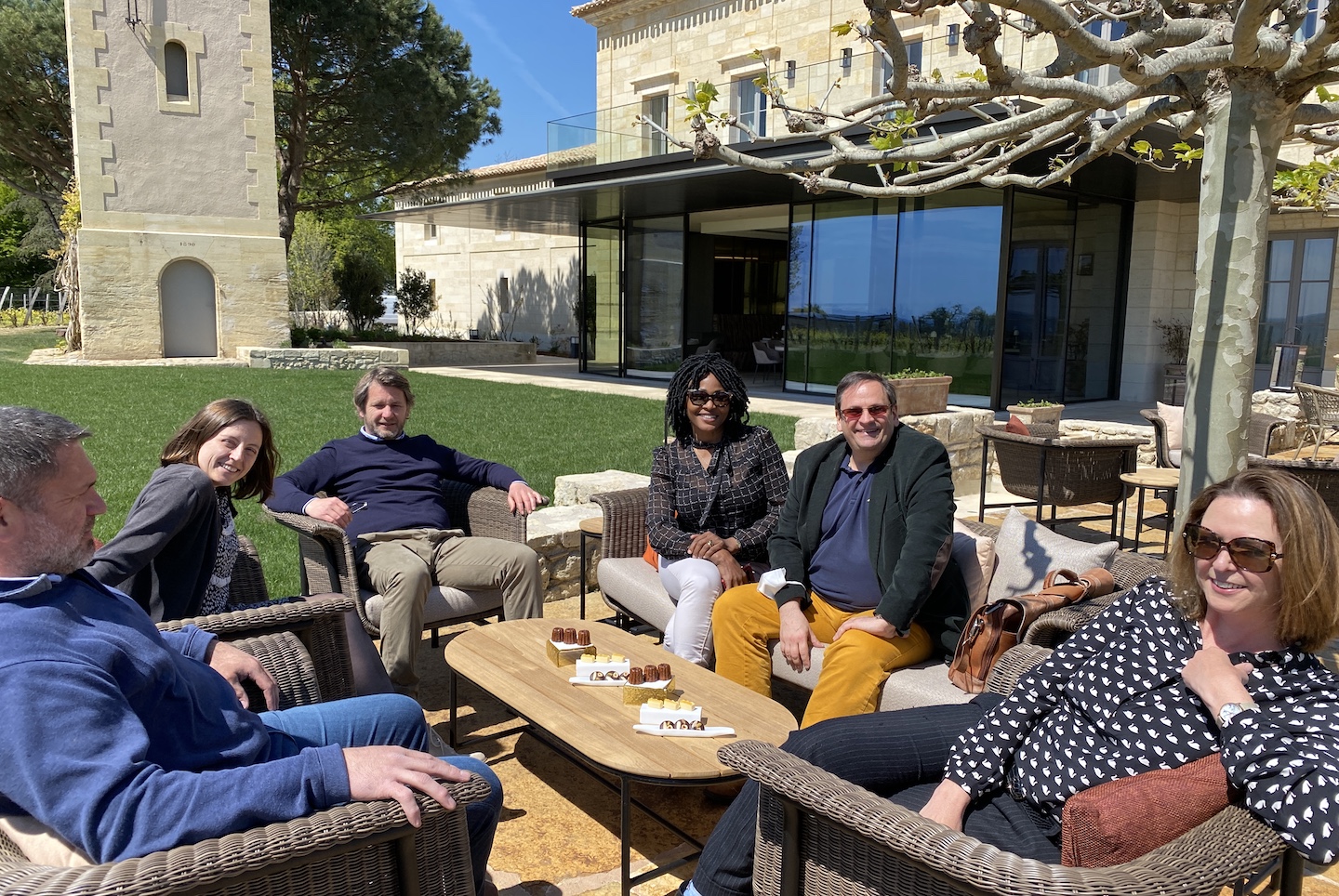
The new look at Château Troplong Mondot after lunching there was so nice, we could have just spent the afternoon lounging on the terrace, but we had to taste barrel samples… .
About the vintage
Thomas Duroux of Château Palmer mentioned a Bordeaux wine trader who says that 2020 is the “first time I see myself struggling with clients to explain the vintage”. A trader I know agreed: “I spoke to eight merchants after they had tasted the wines, and I got eight different interpretations”. Says wine consultant Thomas Duclos: “2020 n’est pas pour tout le monde. Il y a un côté sauvage dans le 2020 que personnellement j’aime beaucoup. Ce petit coté ferme des tanins en milieu de bouche qui va se civiliser à l’élevage”. Basically, the vintage is not for everyone, and that he likes a wild aspect to the wines, while addressing a somewhat firm aspect to the tannins that will be softened (“civilized”) with barrel aging.
My take: Left Bank and Right Bank
As you can read in my initial review of Bordeaux 2020 in Club Oenologique, the vintage can be fantastic for Merlots, especially from vines grown on cooler limestone and clay soils. 2020 confirms that the Right Bank is back. After years in a “modernist wilderness”, with too many wines having excessive oak extraction, overripe fruit, excessive alcohol and too little acidity, wines since 2018 reflect more their soils and terroirs. For the first time in a long while we have a vintage that proclaims “Saint Emilion”, albeit with (many) other stars from Pomerol, Fronsac and the so-called satellite appellations from the Côtes (Castillon, Bourg, etc) especially with cool limestones and clays.
On a general level, the Cabernets were not as seamless as the Merlots: Please refer to my text in Club Oenologique to read why. And it is telling that many estates on the Left Bank, known for Cabernet Sauvignon, had higher-than-average proportions of Merlots in their blends.
But 2020 has excellent Cabernet Sauvignon-dominated wines from the Left Bank. One does find that “closed aspect” of tannins described by Duclos. While some Left Bank wines have that “wow” factor, more of them command intellectual respect. Think of a modern version of 1986 or perhaps 2005 for the better wines. Wine geeks will look forward to long discussions assessing these wines. Hindsight is … 2020, and perhaps the Left Bank may be under-estimated at this early stage. They have high tannin levels, but alcohol and acidity is in balance: After cellaring, some will turn out to be sensational.
A word on 2019 (and pricing)
Price is key, as well as the exchange rate. Futures are being released as this text is being published, and I suggest that readers follow Liv-ex for timely price related news. Members of Liv-ex (The London International Vintners Exchange) get access to the most comprehensive database of real-time transaction prices and receive exclusive market data and insights.
One broker told me that, with a few exceptions, châteaux should have 2019 release prices. Why? First off – and especially for the Left Bank – 2019 seems the better vintage, both in terms of quality and economics. Fellow wine taster Mark Golodetz addressed that in a Facebook post, and he is right. Especially for U.S. buyers, as the dollar has weakened and will probably get weaker as trillions get printed under Biden Administration programs. Purchased for less, 2019 still flies under the radar, as its futures campaign was eclipsed by COVID-19, and is sandwiched between the (more hyped) 2018 and (what may turn out to be more hyped) 2020. 2019 also was superb for many Right Bank estates.
TASTING NOTES
Most wines below are red bold and underlined, too: my top category. An asterisk* in the first two sections means a likely positive price/quality ratio. The (i)Deals are all asterisks, by definition, and I strongly encourage readers to purchase (i)Deals wines, either as futures or off shelf.
TOP 15 EMOTIONS
These top wines elicited the most immediate excitement as barrel samples.
Château Lafleur Pomerol – Along with Petrus, Lafleur jointly shares top wine of the vintage. Having met with owner Baptiste Guindaudeau and cellar master Omri Ram, I was not surprised but rather amazed at just how … stupendous the Lafleur is in 2020. The others wines they craft were also of such high caliber, as expected. Indeed, their Grand Village and Les Perrières de Lafleur (and of course Les Pensées) were superb. But Lafleur transcends the vintage. I did not take many detailed notes, as the wine itself overshadowed the hundreds of other barrel samples I assessed (Petrus is up there, Château Margaux comes close in its own style). It exudes distinct juiciness yet with such incredible structure that you do not even notice until you end your sip, as if the greatness echoes for minutes. And I drank that barrel sample. After the tasting, I walked towards Petrus to take some photos, and I could still taste the Lafleur: “My, my, my, what freshness!” And yet the density is so impressive, too. About 14.5% alcohol, with refined tannins lending an impression of floral freshness. Early picking from hot gravels made sense: the 46% Bouchets (the family prefers using this term over Cabernet Franc) picked by 18 September and the 54% Merlot by … 10 September. If you have the means, buy what you can. And if you cannot afford this, their other wines will make you (nearly) as happy. 99-100
Post-Script: Readers should pay heed to the minute production (only .7 hectare) “second wine”, Les Pensées Pomerol, with more clay soils that work so well with the vintage. 71% Merlot and 29% Bouchets picked by 18 September, and aging in 25% new oak thrived in deep clay, yielding a wine of both mid-palate juiciness and impressive density. A top wine of the vintage. 96-97
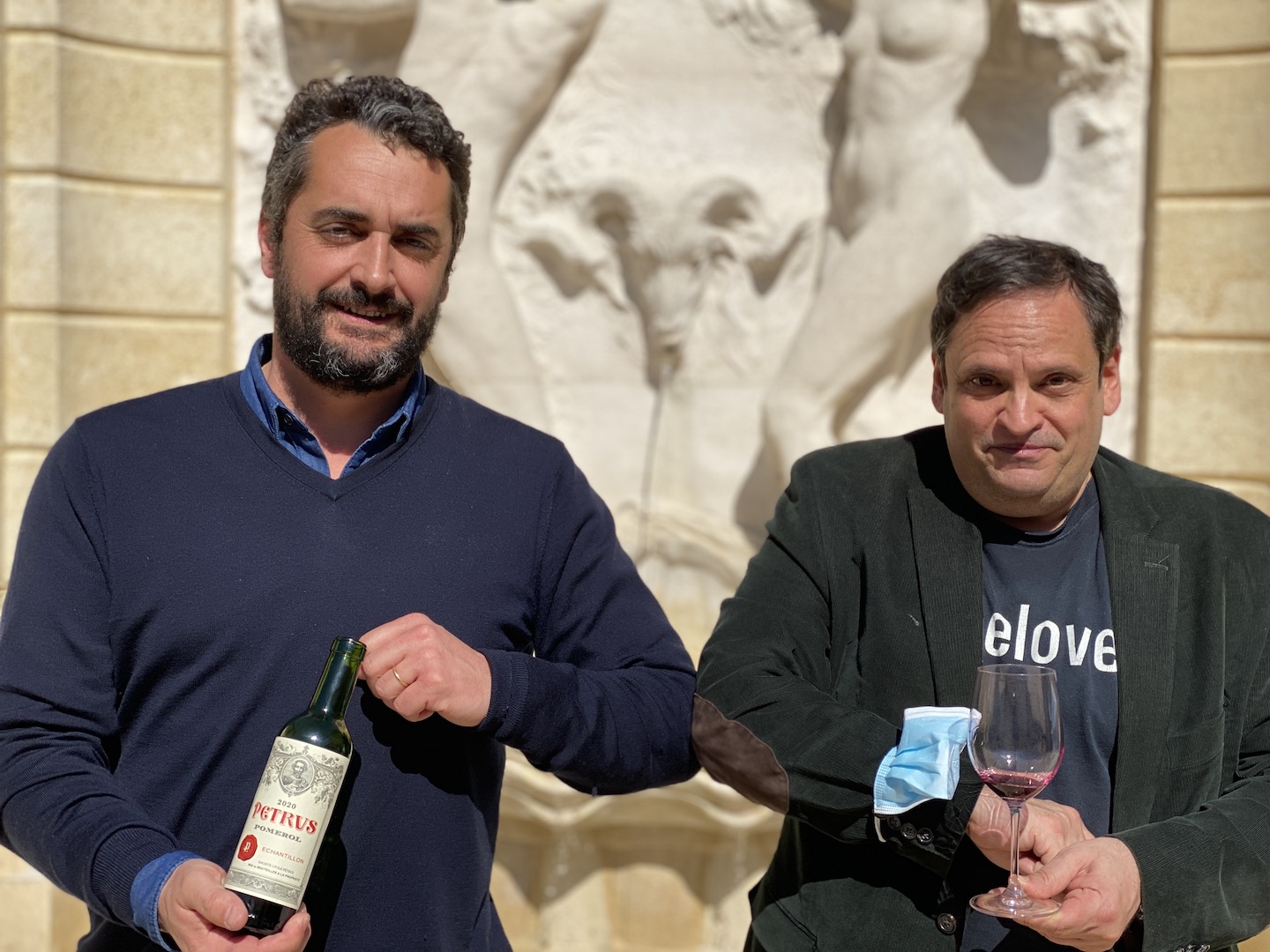
With Olivier Berrouet, director at Petrus
Petrus Pomerol – I had a similar “WOW” reaction to Petrus, assessed with director Olivier Berrouet. The tasting experience here matched my profound excitement from the 2005 as tasted from barrel. Aromas of anise, cherry, deep violet and dark chocolate evoke both freshness and density. And the palate is unforgettable: such juicy density and length is hard to come by. I had been tasting top Pomerols like Vieux Château Certan, Evangile, Conseillante, Petit Village among others and Petrus put them in the back seat with even more authority in 2020 than usual. With such sumptuousness. The prominent tannins are oh so suave. The finish lasts for minutes, marked by floral freshness and white tobacco. Olivier said that the end of August “surprised” his team. Fruit ripening was slow and then in the first week of September a “big acceleration”. Some 30mm of rain in mid August did help lead to that acceleration, he said, although the deep blue clay of Petrus retained moisture for the Merlots not to feel stressed by the arid summer. What helped to retain freshess, he said, was “great weather” in September, with cooler nights, even during August. No de-leafing in June or any green harvest here. The harvest, as at Lafleur, was rather early: picking from 5-18 September. Extractions as ever were careful: Less pumping over than usual, and fermentation temperatures carefully raised each day, never went beyond 27°C. The alcohol is 14.6% and the pH is 3.65. 99-100
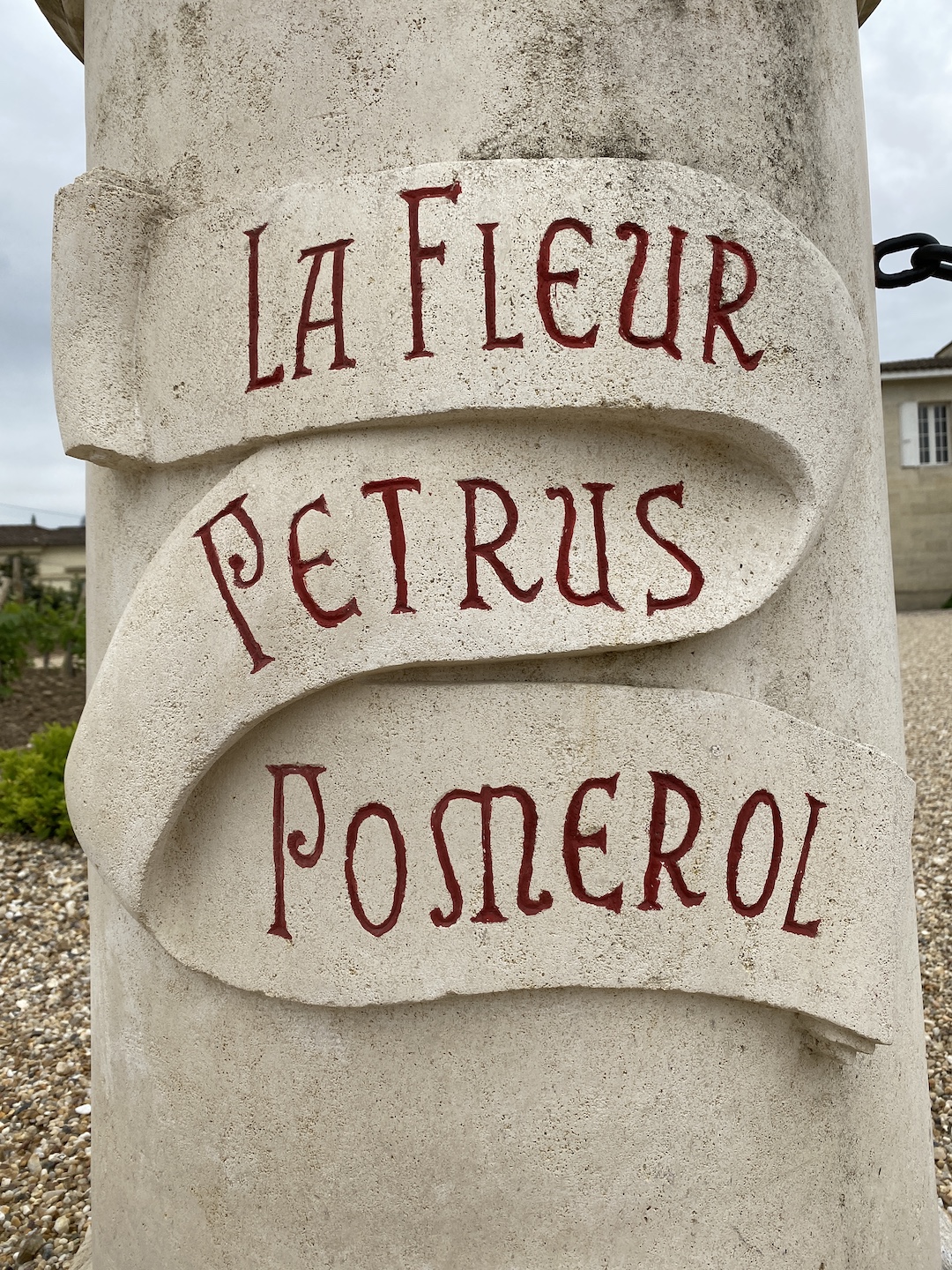
Best La Fleur-Pétrus I recall tasting from barrel.
Château La Fleur Pétrus Pomerol – This blend of 93% Merlot, 5% Cabernet Franc and 2% Petit Verdot indeed communicates emotional excitement, the (sun reflecting) deep gravel successfully conveying ideal ripeness (not too hot) to the fruit, and the underlying clay offering impressive depth and sap. Aromas are subtle. More wet stone than anything else. Some violet. The palate is veritably suave and even silky in expression, with gorgeous tannins over a deceptively “soft” structure. The Fleur in La Fleur Pétrus is in focus. A truly “spherical” wine. Not sure it’s better than Trotanoy, however, but there is a “wow” factor! And it seems more suave than the Trotanoy. 97-98+
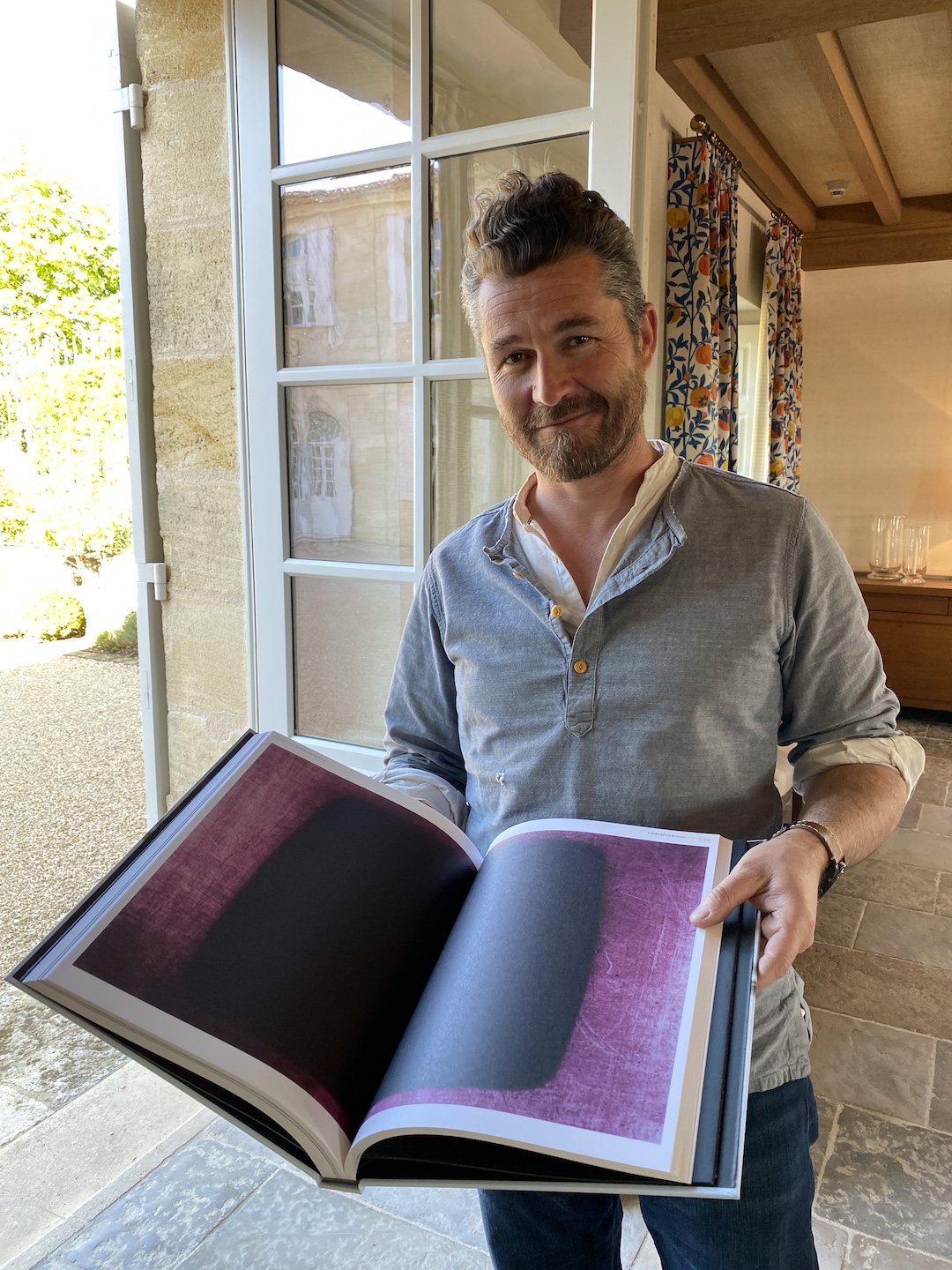
Director on both sides of Gironde: Nicolas Audebert of Château Canon and Château Rauzan-Ségla with a great new book.
Château Canon Premier Grand Cru Classé Saint Emilion* – Here a wine that rivals and at least equals the splendid 2019 vintage. Indeed, a Saint Emilion that got us oohing and ahhing as tasted with director Nicolas Audebert, and again doing so well in a group tasting at Château Belgrave. Why? Such “effortless grace”, tasted on two separate occasions with similar results: freshness reflecting limestone terroir with peerless refinement on the palate, such airy elegance as well as subtle density and subtle power. Floral yet brisk, with fabulous balance leading to a sea breeze, saline finish along with more floral aromas. A blend of 68% Merlot and 32% Cabernet Franc, clocking in at 14.5% alcohol with a pH of 3.53, to age 18 months in 50% new oak, this is a wine to purchase. 97-98+
As a postscript, the second wine, Croix Canon*, displays crisp yet ripe fruit. Croquant, as the French say. Blending 65% Merlot and 35% Cabernet Franc, clocking in at 14.5% alcohol, I love its vif d’esprit aspect, and you do not notice the alcohol with a low pH of 3.53. Since 2015, only Croix Canon vines in Croix Canon, coming from sandy and limestone erosion soils that had been purchased in 2011. 93-94+
Château Margaux Premier Cru Classé Margaux – Estate director Philippe Bascaules calls it the best vintage since 2015, which is already legendary here. Although I do not think that the 2020 quite matches the 2015, its gorgeous white flower and ripe fruit basket aromas enchant the taster and transcend the vintage quality for the Left Bank. The wine – only 36% of the harvest used to make this grand vin – clocks in at 13.5% alcohol, blending 89% Cabernet Sauvignon, 8% Merlot, 2% Petit Verdot and 1% Cabernet Franc. The tannins are not only silky and suave, but also powerful. The tannic index is superior to that of 2019 but not quite at the level of 2018. The sample we had assessed was drawn the day before, and the wine’s concentration and density are such that the estate prefers to wait a day before having it tasted. With time in glass, you sense the velvet texture and a kind of “wave” of momentum given the powerful tannins but it is never hard, never drying, leading to more floral notes and some eucalyptus on the long finish: a chef d’oeuvre. Bascaules explained at length how the 2020 was least affected by heat stress out of the three last “solar” vintages 2018, 2019 and 2020. Furthermore the alcohol at 13.5% is a half degree less than in 2018 and almost a half degree less than in 2019, so the balance achieved here is more typical of Château Margaux. Tasted with Jane Anson inside the gorgeous mansion, it was fascinating to have tasted already Château Lafite Rothschild, Château Mouton Rothschild and Château Latour and then finishing with the top wine of the Médoc, coming from a more challenged appellation than Pauillac. Château Margaux can be as comfortable in the “intellectual” category as in the “emotional”, but it did leave a “WOW” impression for both senses. It has the poise and power of Latour but with more charm. A unicorn wine, and one to purchase if you can afford it. Bravo! 97-98+
As a postscript, the second wine of Château Margaux – Pavillon Rouge* – is also a great success, showing off notes of graphite and violet, and quite concentrated yet classically refined on the palate, with ripe and velvety tannins. 31% of the harvest was used to make this wine, blending 75% Cabernet Sauvignon, 18% Merlot, 5% Petit Verdot and 2% Cabernet Franc anc clocking in at 13.6% alcohol. A top second wine from Médoc. 95-96
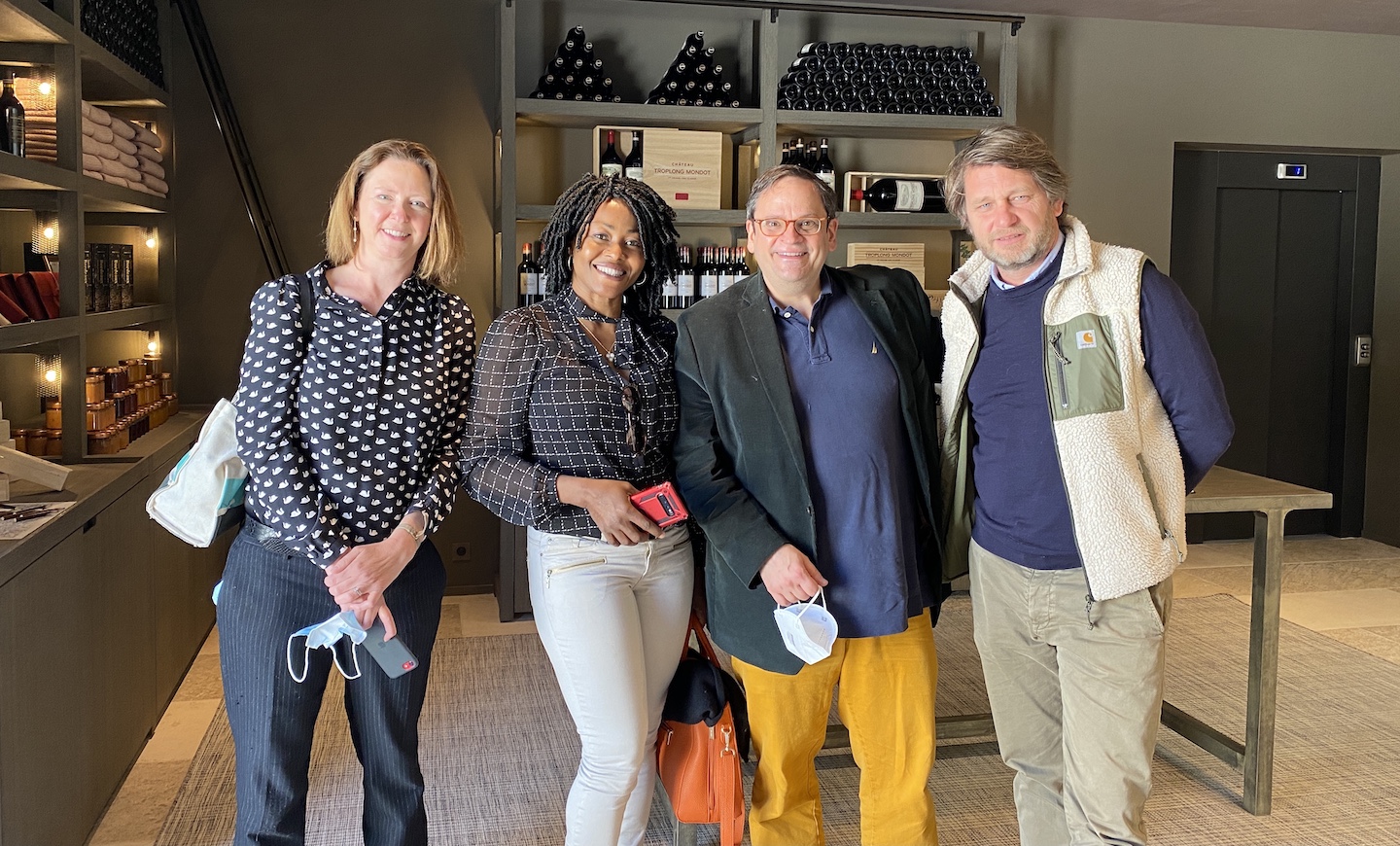
All smiles with Aymeric de Gironde, at far right, at Château Troplong Mondot. With the great wine author Jane Anson and Chinedu Rosa of vinesbyrosa.com
Château Troplong Mondot Premier Grand Cru Classé Saint Emilion* – Lovely grip and freshness, racy opulence and juicy on the palate, with a long finish marked by orange zest. This blend of 85% Merlot, 13% Cabernet Sauvignon and 2% Cabernet France underwent gentle extractions because tannins were high. As with other estates, director Aymeric de Gironde said that 2020 was the “earliest harvest we ever had”, starting on 4 September, finished on 30 September, depending on vine plots. I wonder if Château Figeac, certainly a different terroir and perhaps just a bit more refined overall, may lose out in terms of power, but there is subtlety to this Troplong too, and I love the chalky finish. The pH is very low at 3.53, fine balance for the 14.5% alcohol, aging in 60% new oak. A top Troplong but look out for the second wine, the 100% Merlot “Mondot”: a superb wine for what should be smaller change. 97-98
Château Trotanoy Pomerol – 100% Merlot in clay and gravel over black clay and crasse de fer, there is no mistaking the amazing aromatics that transcend the already splendidly exciting Latour à Pomerol. At once sap driven and fresh, with violet aromas and such juiciness on the palate, and the extent of balance between acidity and alcohol makes it one of the most seamless wines of the vintage! Not far behind Petrus, but it doesn’t match the “super excitement” of that latter wine. But it also comes with a lower price tag… interesting to note however that the structure of the vintage does show itself on the finish. Not austere in any way, but you sense the construction going on, like the construction going outside the Moueix offices this Monday morning, 26 April 😃. 97-98
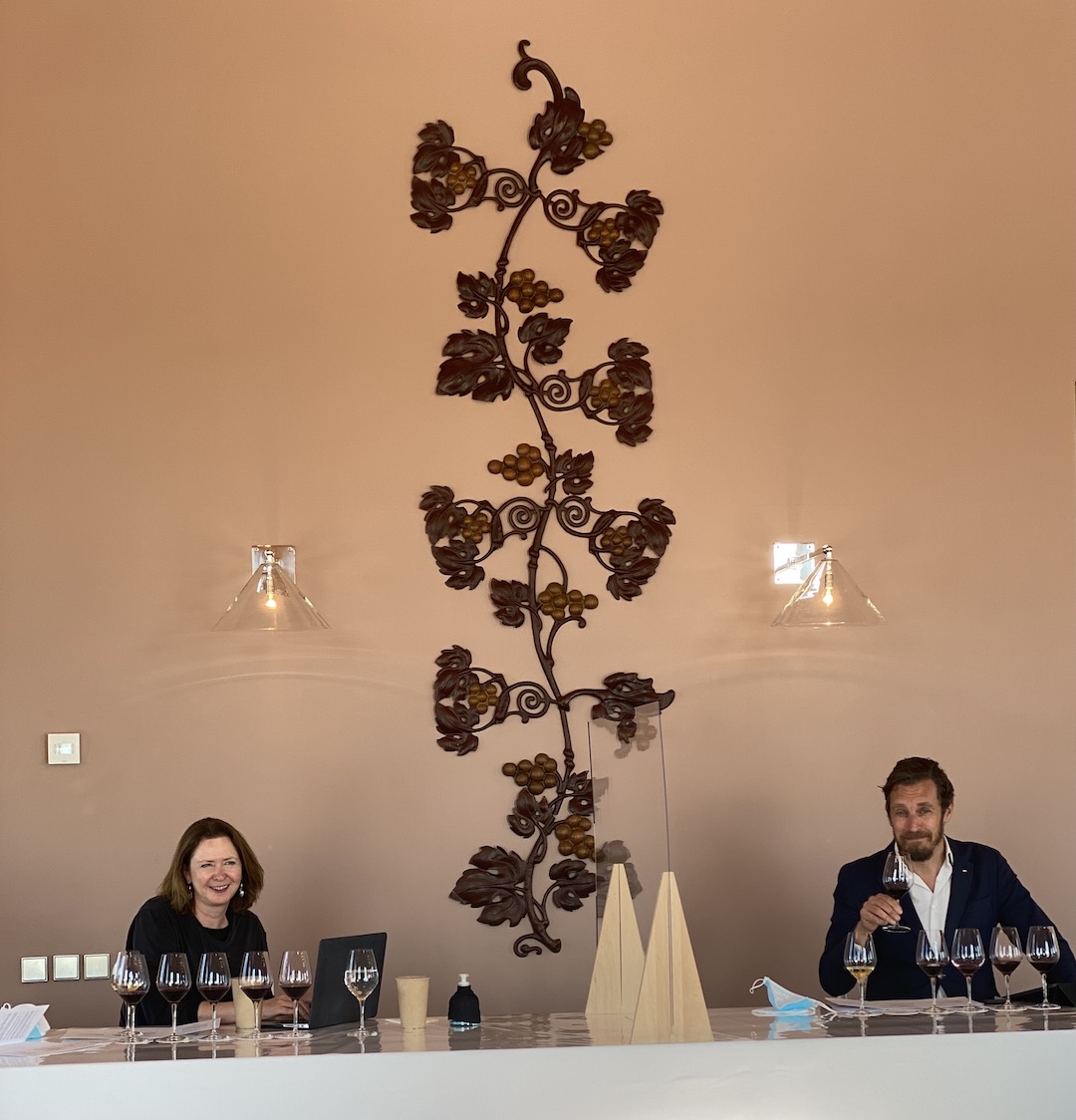
Jane and Francis Anson tasting the 2020s at Clerc Milon in Pauillac.
Château Mouton-Rothschild Premier Cru Classé Pauillac – I admit to being in an awful mood after having just accidentally spilled Lafite Rothschild on my keyboard after having tasted that lovely wine at the estate earlier the same morning, and the MacBookPro subsequently going dead. But no bad mood dissuaded the positivity of this superb Mouton, blending 84% Cabernet Sauvignon, 13% Merlot, 2% Cabernet Franc and 1% Petit Verdot. It is a close call in 2020 between Mouton and Latour, but they each play on their strengths: the Latour more about quiet majestic power, the Mouton more ostentatious. Indeed, the nose is more expressive, with both sumptuous blackberry, cherry and cooler blueberry fruit aspects: all very ripe but also refined. The attack is both vif, brisk, but also enveloping leading to a suave and succulent mid palate. The long finish is marked by sweet tobacco aspects, so, really, fans of Mouton – fans of great wine – will find much to love here. And I write this on the MacBookPro, with thanks to dear friend Francis Anson, who found a technicien who ended up fixing the problem… All’s well that ends well. 97-98
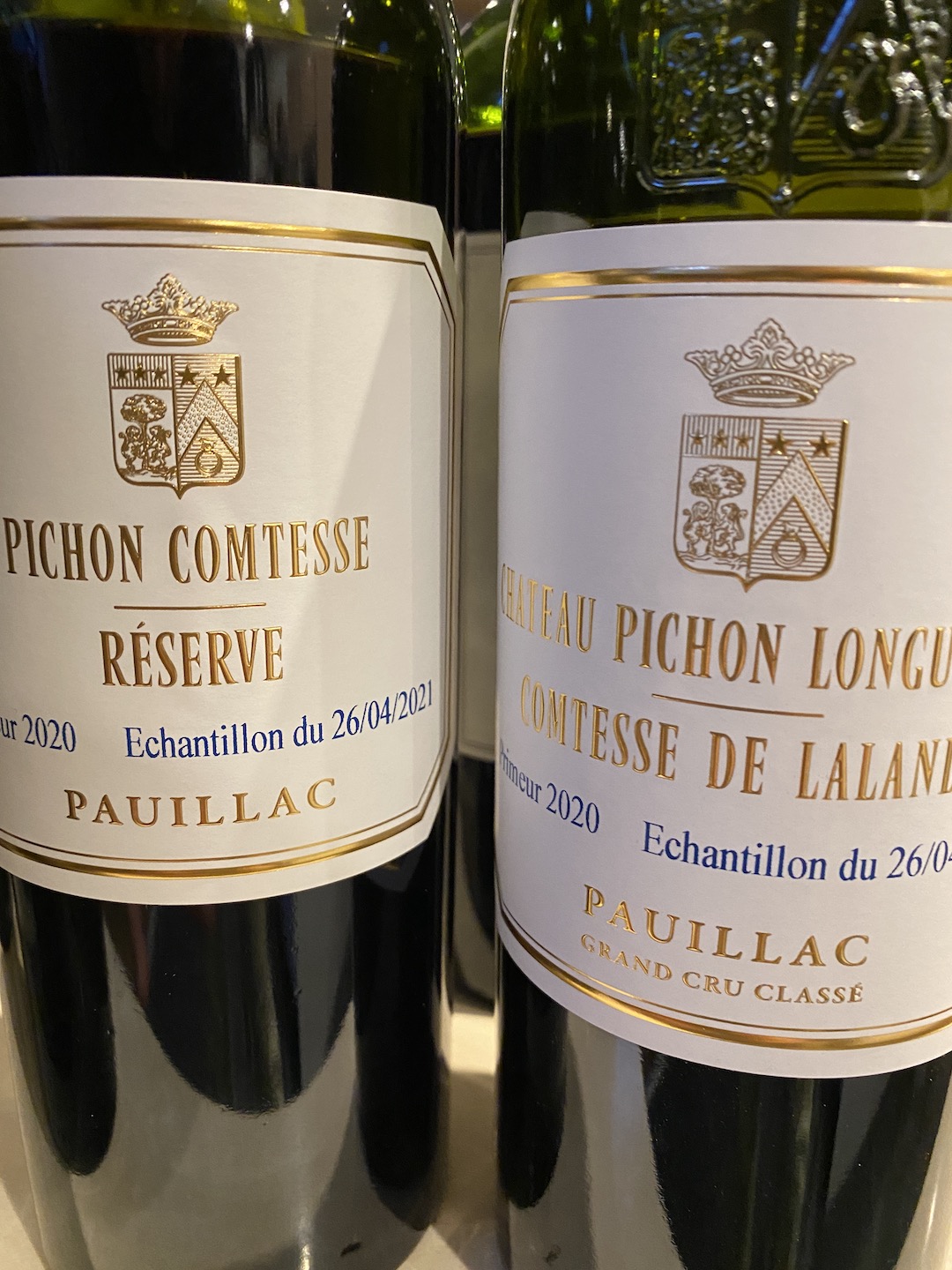
And, yes, the second wine is also excellent…
Château Pichon Longueville Comtesse de Lalande 2ème Cru Classé Pauillac* – What a splendid wine! Suave and opulent, and as Château Latour technical director Hélène Génin had kindly commented about having tasted it: “It comes across so opulent and appealing”. Pure aromas exude Pauillac graphite, cedar and ripe fruit. It is at once racy and juicy on the mid palate, and I agree with what the estate itself uses as a descriptor: a “spherical wine”. Blending 77% Cabernet Sauvignon, 17% Merlot and 6% Cabernet Franc, the wine clocks in at 13.6% alcohol. However, one also senses a more-than-usual foreboding sense of tannin, boding very nicely for long term aging. The depth and density and long finish include a sense of succulent charm that one expects from La Comtesse. This estate has been on such a roll in recent years, you can buy just about every vintage, and also the second wine. The 2020 matches the superb 2019 in quality, with perhaps a bit more density, but it will be fascinating to compare the two over time. Director Nicolas Glumineau (and his team) has the Midas Touch. 96-98
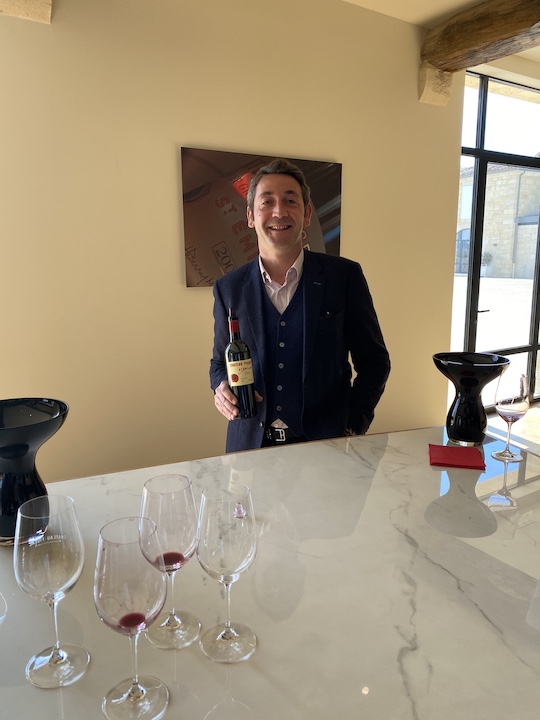
On a roll at Château Figeac: Frédéric Faye
Château Figeac Premier Grand Cru Classé Saint Emilion – What can I say but to applaud this wine’s sense of refinement, finesse, elegance and density. This could easily have been placed in the second category, but it has much appeal emotionally as my first tasting from barrel of the 2020 vintage. A superb wine blending blends 37% Merlot, 32% Cabernet Franc and 31% Cabernet Sauvignon. It may well equal the 2019, which I adored. Director Frederic Faye calls 2020 a “winemaker’s vintage” as it “depends on the estate and not so much the appellation”. He showed off the estate’s impressive new cellar space, including barrels being stored many meters underground to ensure properly cool and humid aging. This will be the subject of a future feature I will pen in Club Oenologique later this year. The success of the Merlots could explain why this grape has more than its typical one-third percentage in the blend. Harvesting from 4 September to 1 October, with some rain towards the end serving here to freshen especially the Cabernet Sauvignons. Clocking in at 13.8% alcohol, I believe that the 2020 is better than the 2018 and could possibly equal the 2019, but it will be interesting to see how this vintage tastes once in bottle. Gorgeous overall. 96-98
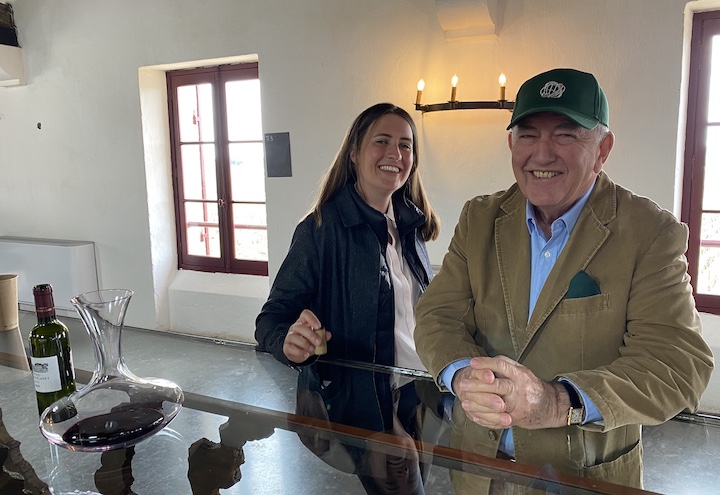
Justine and father Alfred Tesseron smiling at Pontet Canet: They know they have great wine
Château Pontet Canet 5ème Cru Classé Pauillac* – Hats off to pure pencil lead aromas, refined tannins, freshness, and such a delectable and juicy, layered palate! Un vin bien enrobé … with tobacco leaf and black tea on the long finish, with a hint of what Jean-Claude Berrouet calls “la bonne amertume” and this is a wine to buy without hesitation. I am hoping that the price will be low, and owner Alfred Tesserson smartly made no second wine. If your entire vineyard can achieve this caliber of quality, why bother? Hats off then to Alfred and daughter Justine. And not just because they provided some incredibly delicious Charolais burgers for lunch in an ambiance still challenged by the pandemic. Picking lasted from 14-30 September. The wine blends 60% Cabernet Sauvignon, 32% Merlot, and 4% each of Cabernet Franc and Petit Verdot, aging in 50% new oak, 35% concrete amphorae and 15% one-year old oak barrels. While the estate experienced dramatic losses to mildew in 2018, they fought it off better in 2020. The importance of having staff available on weekends was again stressed here as it had been by Edouard Moueix in Pomerol. In any case, about 20 percent less than an average harvest, but not the huge loss of 2018. The wine gets an easy nod into any Top 15 category for excitement, but also elicits intellectual delight. 96-98
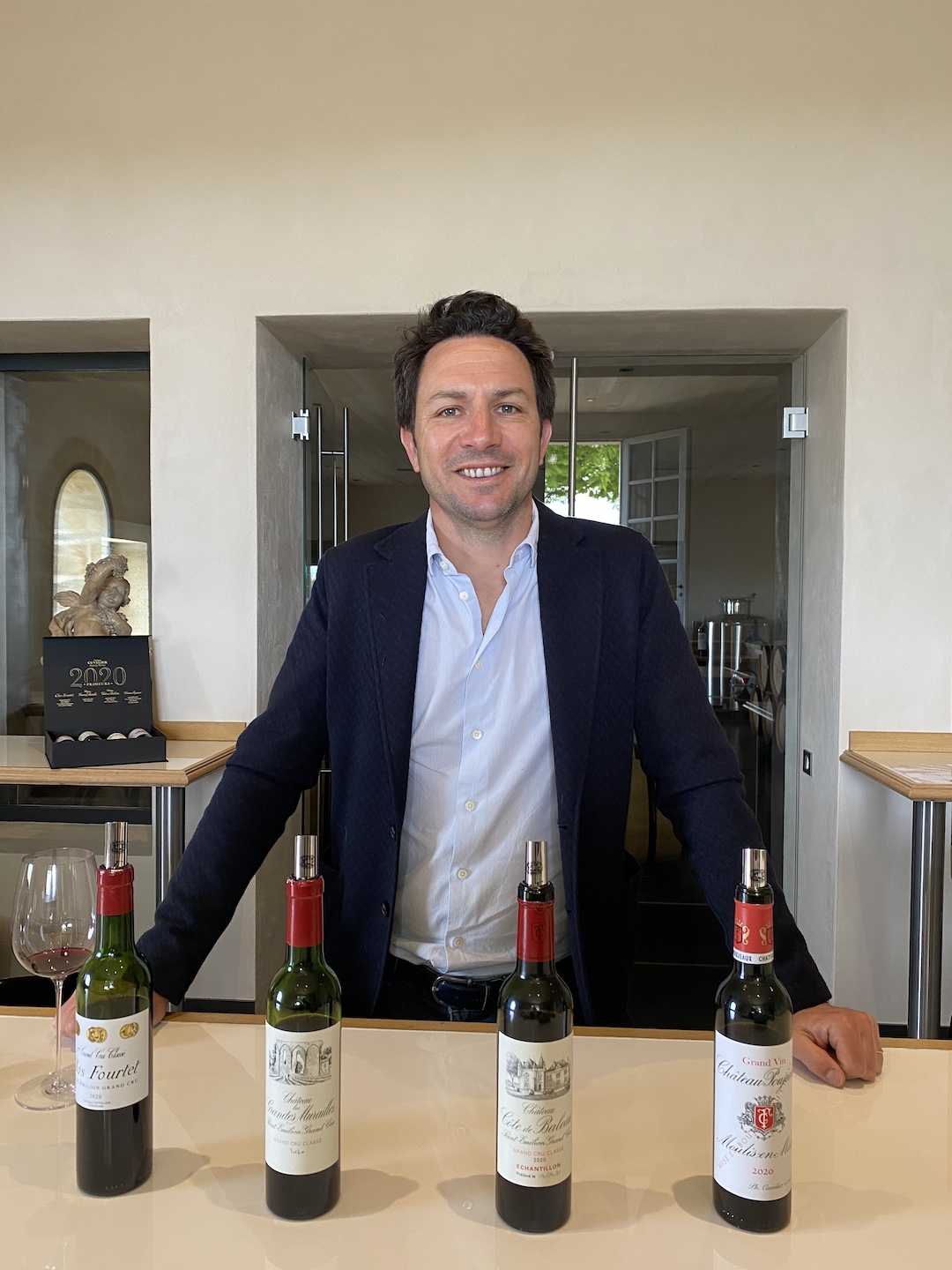
Matthieu Cuvelier of Clos Fourtet: another example of superb wine where the cooler clay and limestone shined in 2020
Château Clos Fourtet Premier Grand Cru Classé Saint Emilion* – The French word envoûtant comes to mind. That is to say: beguiling. I cannot recall a more positive tasting experience from barrel from Clos Fourtet and rate it very highly in this vintage. Mainly because of its superb density, yet subtle focus and linearity. It takes time however. At first, a bit closed on the nose, but then gets beguiling chalky with wet stone notes. One appreciates impressive density, succulent fruit, finesse and length from this blend of 90% Merlot, 7% Cabernet Sauvignon and 3% Cabernet Franc. The alcohol is 14.5% but with a balancing pH of 3.6 from cool limestone and clay soils. You get juicy richness, precision and focus. Cooler northwestern facing vines pay dividends in hot, dry summers. Aging in 50% new oak. A wine to buy. 96-98
Château Larcis Ducasse Premier Grand Crus Classé Saint Emilion* – Like the 2018, this vintage impresses with exemplary density. Tasted 3 times. I know that fellow taster Jane Anson finds it very special in 2020, and you get such appealing wet limestone purity from the blend of 90% Merlot and 10% Cabernet Franc. Director Nicolas Thienpont says the 2018 is just as dense – a wine I purchased – but lacks the same energy as the 2020, which could explain why many tasters rave about it. Again, 2020 proves superb for Merlot picked from vines grown on deep clays and limestone, where the nearly 10 hectares of vines grow here. A very high score, and the price should be competitive. I will buy this… 96-98
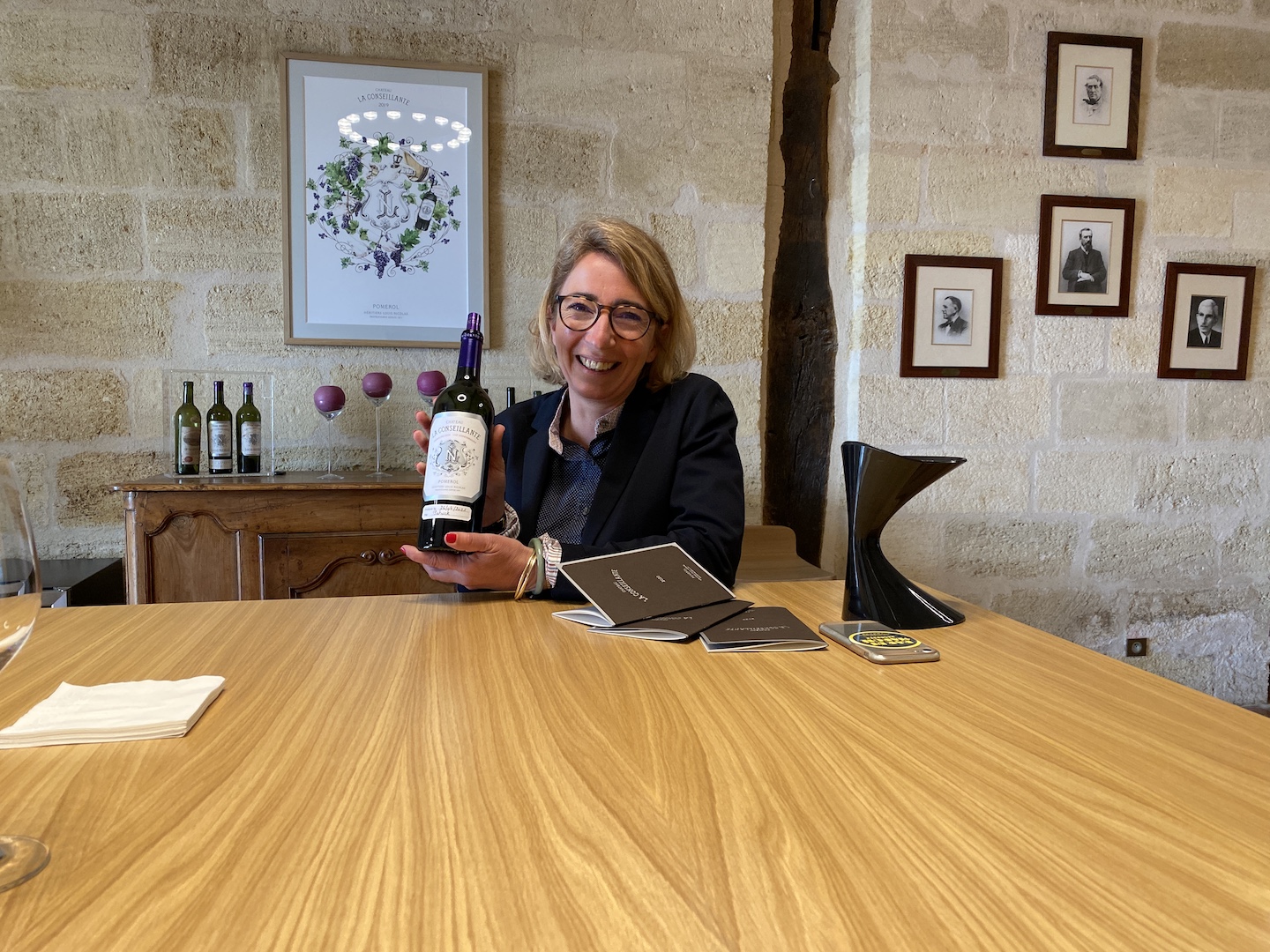
Marielle Cazaux is on a roll at La Conseillante
Château La Conseillante Pomerol – For this sample drawn on 26 April, a very fresh and floral (also flower stem) expression such as peonies. The palate has much exciting energy. “2018 is tighter, while 2019 is wider and maybe sexier but a bit less long and bright”, says director Marielle Cazaux. So, like others have noted, 2020 can be considered a theoretical mix of 2018 and 2019. “Plus a hint of 2010,” she adds. What I find is a véritable élégance with “soft” density and “wet stone minerality” from this blend of 87% Merlot and 13% Cabernet Franc, clocking in at 14% alcohol and aging in 70% new oak. In short, a wine that seduces the taster with charm and intellect, but I tip my hat here to emotional aspects more. The warm summer included nine days of up to 40°C, but “we had good canopy management given experience from prior vintages”, Cazaux explains – and only morning harvesting (which ended on 30 September) to avoid afternoon heat grilling the grapes, and lighter extraction in the winemaking process. 96-97
Petit Cheval Saint Emilion / Second wine of Château Cheval Blanc* – Yes, I count the second wine of Cheval Blanc as a “wow” wine. Fruit driven, chiselled, juicy and long on the finish, this blend of 59% Cabernet Franc and 41% Merlot comes from vine plots that had been picked for the first wine from 2019! This is truly an alter ego, and should not be treated as a second, especially in 2020. For the (expected) price, I would not hesitate. An amazing entry from the vintage. The senior sibling falls more into the “intellect” category (see below). 95-97
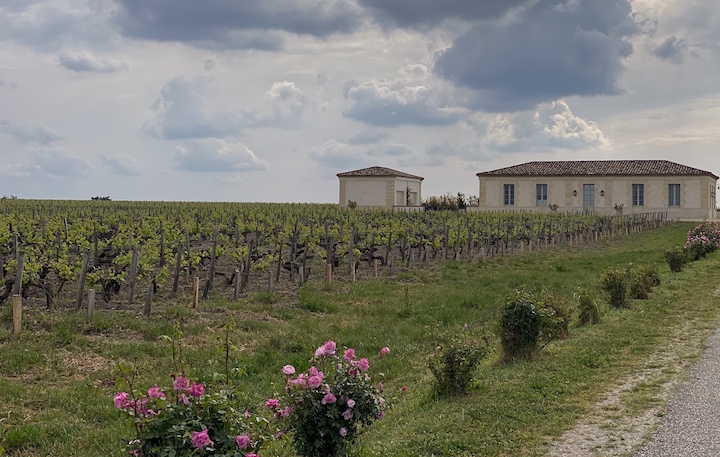
Château Montrose looking gorgeous on a late afternoon: one of the top “intellectual” wines of 2020 as tasted from barrel.
Top 15 intellects
Old Timers could compare the emotive category above to wines closer in style to 1982 and the geek factor wines here closer to 1986. A more recent comparison could be the 2009s and the 2005s. The former more about lusty excitement; the latter more about structural enlightenment.
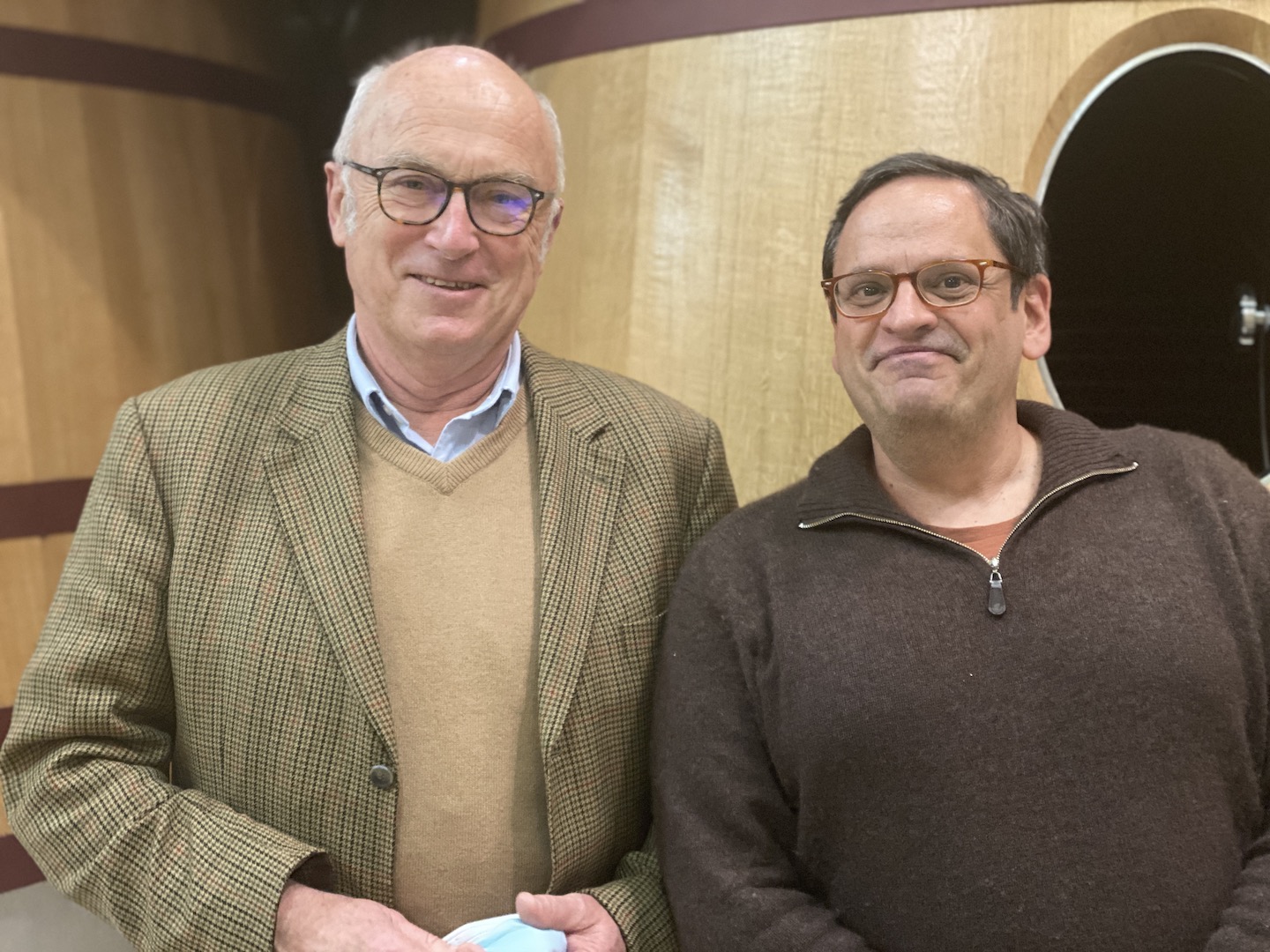
With Alain Vauthier at Château Ausone: Perhaps the longest distance runner of 2020
Château Ausone Premier Grand Cru Classé Saint Emilion – Here another case where the wine is more about density rather than charm. Unlike Cheval Blanc, the nose needs coaxing from this blend of 50-50 Cabernet Franc and Merlot. As much as it can open in glass at this very early stage, the wine reveals incredible density via a layered palate of refined tannin, displaying the distinctly appealing wet stone aspect typical of the great limestone terroir here. On the finish, fine dark chocolate reveals itself. Still, this is a more intellectual star of the vintage rather than sensual. It clocks in at 14.71% alcohol, with a pH of 3.58, aging in 100% new oak. What convinces me is the impressive density, but a wine that demands 15-20 years before opening. 97-99
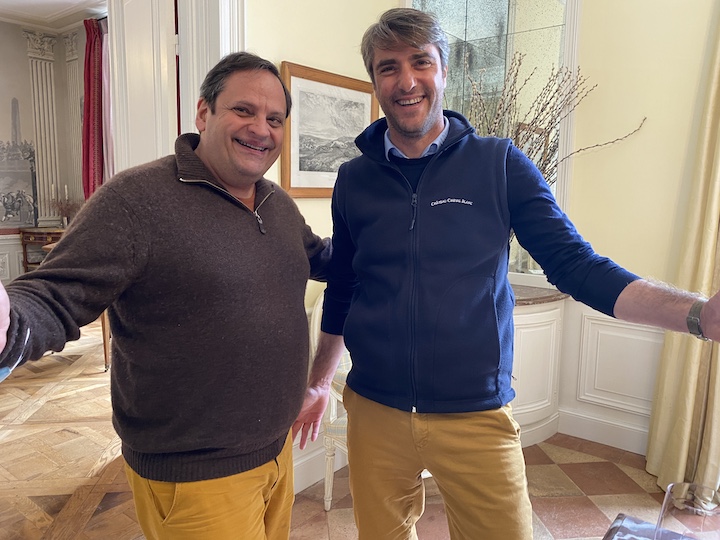
I love both Petit Cheval and Cheval Blanc for different reasons. With Pierre-Olivier Clouet at Cheval Blanc.
Château Cheval Blanc Premier Grand Cru Classé Saint Emilion – As technical director Pierre-Olivier Clouet remarked, like many others I met with in Bordeaux during late April: “This is a vintage that favours Merlot”. And he agrees with the idea that it resembles 1998. In a modern sense. At Cheval Blanc in 2020, the Merlots give structure, while Cabernet Franc lends freshness. I am not as beguiled as I was in 2018, but this is a great wine in the making, more sober in expression as compared to the flamboyant 2018. It will require time in your cellar to “come around” while the Petit Cheval is already singing, as seen above. Aromatically, the wine is already simply gorgeous with black pepper, violets, tobacco and blackberry fruit: very inviting. But the palate at this stage comes across more taut: “This is a vintage where the palate is more ‘academic’, while aromas are more expressive” Clouet said. Indeed, The palate is “direct” and “frank”, but do not let that fool you: this will develop into a beauty with 10+ years in your cellar. The blend is 65% Merlot, 30% Cabernet Franc and 5% Cabernet Sauvignon, with alcohol at 14.2% and a 3.72 pH. 97-98+
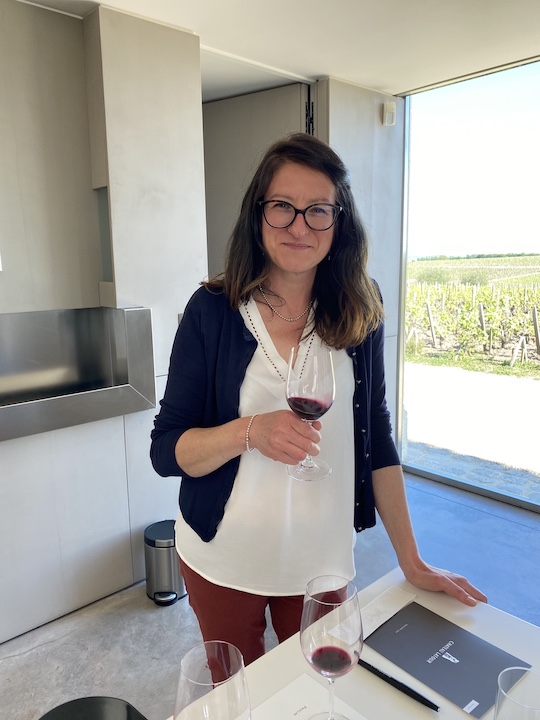
With Hélène Génin at Château Latour.
Château Latour Premier Cru Classé Pauillac – A wine of quiet majesty, where the taster is most impressed by a cool attack leading to a pristine and linear approach on the palate, with lead pencil and cassis dominating the show in this blend of 97% Cabernet Sauvignon and three percent Merlot, clocking in at 13.3% alcohol. The tannins are foreboding but regal at the same time, an almost silky feel to them, but one senses the power throughout – a confident power, a subtle power – with the tannic index reaching an impressive 83 IPT. The index was 87 for the 2016 vintage, recalls Latour technical director Hélène Génin, so 2020 counts “among the highest tannins we have seen”. 2020 especially on the Left Bank is about tannin management, and Latour succeeds in spades. The harvest was 10 days earlier than normal, ending on 28 September, with very small berries, rather concentrated. Among the three First Growths in Pauillac, I tip my hat to Latour in 2020 for its refined purity, subtle power and impressive length. Clearly a wine of sophistication that one would expect to shut down before reaching a complex bouquet and proper drinking window in about 25 years. 97-98+
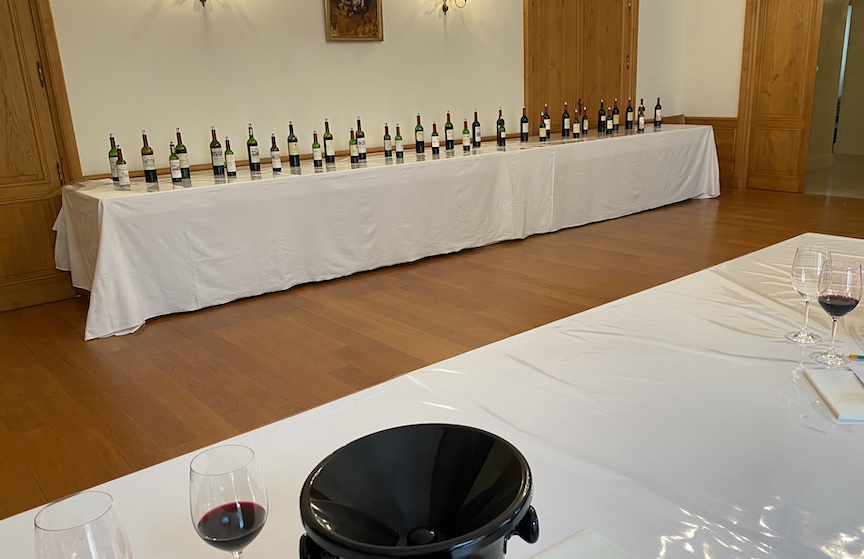
Great tasting at the Moueix office in Libourne, with a star of Saint Emilion: Belair-Monange.
Château Belair Monange Premier Grand Cru Classé Saint Emilion – While more structured than, say, Château Canon, the tannins display impeccable finesse. The wine shows impressive density. However, not as much “sheer excitement” as I had experienced from the 2019 from barrel. The 2020 wins in terms of density, however, and time in glass brings out aromatics and mid palate sap from this blend of 98% Merlot and 2% Cabernet Franc. Tasted at the Moueix offices in Libourne along with some superb Pomerols. Édouard Moueix says it’s ”far too early” to apply for an A rating, as it’s “only been 13 years” since it was taken over as a Moueix property. But this estate with vines on both the limestone plateau and on blue clay and limestone is magnificent, bordering Ausone. The progress over the last decade has been superb. 96-98
Château Lafite-Rothschild Premier Cru Classé Pauillac – A pinnacle of refinement, so subtle and yet so opulent, but not at all ostentatious. This blend of 92% Cabernet Sauvignon, 7% Merlot and 1% Petit Verdot reflects a vintage that was difficult at the beginning, but the summer worked out, with stress being “perfect” in July, recalls director Eric Kohler. Enough rain fell in August to freshen the grapes leading to what Kohler dubs “an incredible, classic and fresh vintage”. Alas I lost my more specific notes because shortly after assessing this wine, as well as an excellent Duhart Milon, I accidentally spilled the wine onto my keyboard, which seemingly killed my MacBookPro with a full week of tasting notes apparently lost. In the end, they were recovered except for the notes taken at this estate… At least in this video with Kohler, you can see genuine enthusiasm in tasting the barrel sample. Kohler furthermore stresses that 2020 is a “very interesting vintage for Bordeaux” because “we can show that even in a very hot year, it is possible to have incredibly fresh and classic wines”. Clocks in at 12.8% alcohol. 96-98
Vieux Château Certan Pomerol – The 2020 edition from this remarkable estate falls into a certain classical refinement, hence more on the intellectual side of the fence. Owner Alexandre Thienpont explained how 2020 saw the “best Cabernet Franc since the 2011 vintage” and there is structure as well as cool blue fruit and mint leaf from the contribution of that grape, making 15% of the blend, with Merlot making up 85%. There is indeed a sumptuous mid palate, but the impression overall is one of impressive density and refined tannin: a wine that requires at least 10 years in your cellar before popping a cork. Unlike some other estates, he welcomed some later September rains, which helped the Cabernet Franc arrive at optimal maturity, hence the picking ending on 29 September here, 11 after the harvest had ended at Petrus. 96-97
Château L’Eglise-Clinet Pomerol – The barrel sample displays much freshness and brightness with density and somewhat imposing tannin, but of the type that will age really nicely. Time in glass reveals a juicy mid palate but the barrel sample stresses more the “splendid architecture” of the vintage. It blends 90% Merlot and 10% Cabernet Franc, with the Merlot was picked between 11 and 14 September and the Cabernet Franc picked on 16 September. Alcohol clocks in at 14.4% and the wine is aging in 80% new oak. 96-97
Château L’Evangile Pomerol – What a stark contrast between the first wine this year and the second, Blason d’Evangile! Here we witness a “sea change” in style, as the second wine more closely resembles the evident richness that has been the hallmark of this estate for many years. What impresses me so much about the first wine is its subtle depth, superior length and precision. Indeed, Evangile exudes refined floral elegance that is missing in the Blason. And its appeal sneaks up on you. Give this some time in your cellar and it will reward you very nicely. However, fans of opulence and (near) decadence will find perhaps more to love in the second wine, Blason de L’Evangile* (93-95). So we have a unique vintage at this estate that “turns the tables” as tasted with director Olivier Trégoat and technical director Juliette Couderc, who arrived in time for the 2020 harvest. Their goal has been to increase finesse for the first wine and they succeed in spades, making this more like a “Lafite Rothschild of Pomerol”, which is under the same ownerhip, so it makes sense. It may lack the power of Eglise Clinet, but it makes up for that in finesse. They also want to slowly add magnesium in their soils that would reduce pH levels. The wines have had very high pH levels that they dislike. It now stands at about 3.8 and can reach sometimes 4. “We would like to stay at a maximum level of 3.8”, explains Trégoat. They have been also reducing the amount of new oak to age the first wine so as to extract less oak tannin, which happens more rapidly the higher the alcohol level in the wine. Indeed, 2020 is the “first vintage” with only 50% new oak, they say. And one remarks that freshness. As one observer who wished not to be named said of the wine: “It is finally tasting like Evangile should taste”. They also aim for organic certification later this year. Harvesting was early, from 2 to 21 September. “We wanted to harvest early to fight a bit of excess ripeness in the past, to achieve more freshness,” explains Trégoat. When a hot weather front arrived in mid-September, grapes picked around that time went into the Blason,” he added, which “has a southern wine aspect” (in French, “Sudist”, referring to the Languedoc). Indeed, there is a jammy ripe black fruit yumminess to the Blason, and I can see how that can sell really well in the U.S. The Evangile blends 88% Merlot and 12% Cabernet Franc, whereas the Blason blends almost the same amount save for half a percent of Cabernet Sauvignon to replace half a percent of Merlot. The hint of Cabernet Sauvignon in the vineyard is in the Blason, as it had suffered a bit from the heat, the team explained. In terms of alcohol, 14.5% for L’Evangile and 14.7% for the Blason. It is worth explaining more about the team: as part of his studies, Olivier carried out a comprehensive soil study of eight of Bordeaux’s top classified growths. As a consultant in the Languedoc, he crossed paths with the Rothschilds, consulting them on the formative stages of Domaine de Long Dai in China before joining the company in 2015. Juliette started work as technical manager just in time for the 2020 harvest. She studied viticulture and agronomy and met Olivier in the south of France. She worked harvests in Chile and New Zealand before Olivier recruited her to work at Long Dai, and she worked three years in China’s Shandong Province. A great team, with a great future. 96-97
Château Palmer 3ème Cru Classé Margaux – Tasted with director Thomas Duroux and the wine is – as one would expect – a top brand for the vintage. It does not quite reach the engaging heights of Petrus, Lafleur or Canon from the Right Bank tasted the day before, but it counts among the very best from the Médoc. The wine is very rich yet sinewy, the high tannins – an index of 78 IPT, which is “very high” for us, Duroux remarks – acts more like a velvety thick layer of fabric even if the tannins are imposing, demanding cellar aging. For this reason, I out this wine in the “intellectual” category, even if the pure raspberry and cherry fruit is lovely. What impresses me most is the greater impression of density as well as the tannin. A brilliant wine with great depth. The blend is 48% each of Cabernet Sauvignon and Merlot and 4% of Petit Verdot, clocking in at 14% alcohol and with a pH of 3.77. 96-97
A postscript, as the Alter Ego* – at 94-95 points – is a success, as well: Rather frank on the attack with an opulent, juicy mid palate. The tannins show power and edge, but are smooth and sinewy. The length and density are not as impressive as with the Palmer, but here a Left Bank second wine that succeeds better than many others (I often got the impression that second wines were less successful in the Left Bank compared to the Right Bank in 2020). The low level of SO2 helps reveal vivid red and black fruit, in this blend of 50% Cabernet Sauvignon, 46% Merlot and 4% Petit Verdot, clocking in at 13.7% alcohol and with a pH of 3.73.
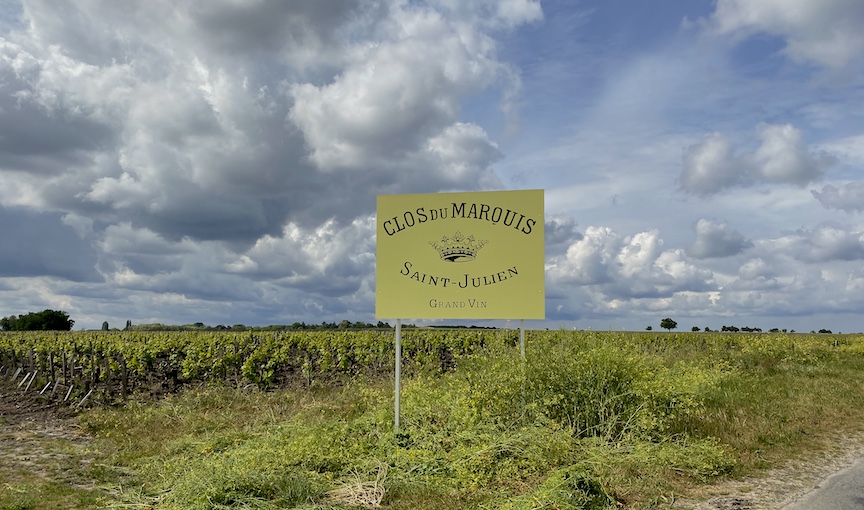
Château Léoville Las Cases 2ème Cru Classé Saint Julien – The subtle power, the hint of pencil lead and the very long finish give off a more sophisticated image at this estate, a clear example of the “intellectual” style, that is not as immediately appealing as tasted from barrel in, say, 2016 and especially 2018, a vintage with flamboyance from barrel. It takes time to coax the nose, but the palate already impresses with power and density. Time in glass – I tasted the wine in the resplendent estate of Château Nenin in Pomerol – and retronasal olfaction yields graphite and crushed mint. It will need at least 15 years in your cellar before you should pop the cork, which means more time to enjoy older vintages or to open the excellent Clos du Marquis* (94-95), which echoes the pure pencil lead aspects of the Las Cases, but with more evident sumptuousness and mid palate juiciness, blending 61% Cabernet Sauvignon, 33% Merlot and 6% Cabernet Franc. For the long run, the Léoville Las Cases leaves you with the impression of finely chiseled tannin. Bravo! 96-97
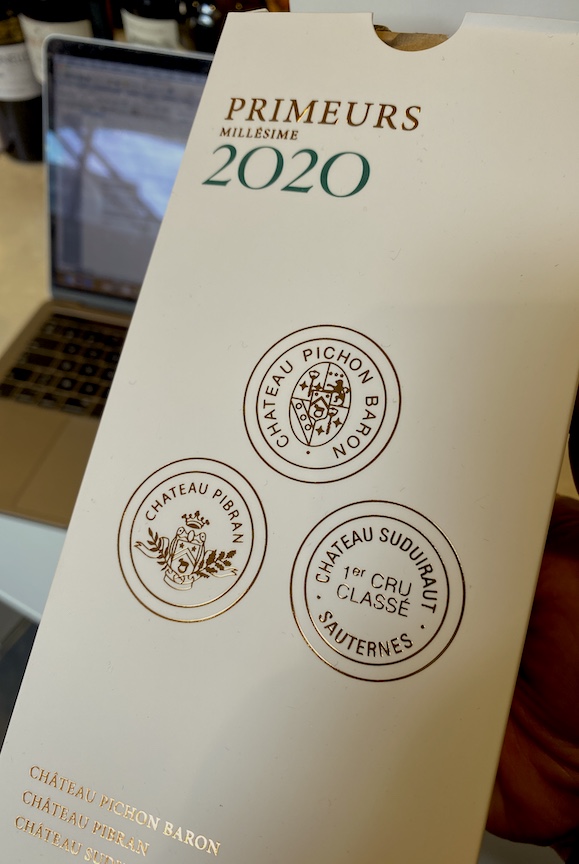
I assessed many samples at the home of Jane Anson. COVID-19 was still an issue… so we visited less estates than usual.
Château Pichon Longueville Baron 2ème Cru Classe Pauillac – The estate boasts the exceptional quality of the Merlots, as to many other estates this year. Pichon Baron however manages yet again a successful Cabernet Sauvignon dominated blend at 76% with 24% Merlot. Much depth to the aromas of graphite and cassis, quite vivid, preceding a rather massive and monumental palate that is also very impressive in its focus, leading to a very long finish from this wine that clocks in at 14% alcohol: a classic expression of power Pauillac with haute couture. Although at this stage I prefer the 2019, when it was tasted from barrel as more elegant. Let’s see how the two vintages compare over time. 95-97

With Hélène Brochet and Vincent Decup at Château Montrose
Château Montrose 2ème Cru Classé Saint Estèphe* – Back to classicism and predictable excellence. Compared to some recent years at well over 14% alcohol, the 2020 clocks in at 13.4% but with a high tannic index at 80 IPT. “We are used to lower alcohols here, so it is back to normal”, remarked technical director Vincent Decup. What I especially like about Montrose is the way it combines the exuberant aromas of a solar vintage – graphite, violet floral, dark (and less red) fruits – with a more classical palate of pristine balance, as seen in the 2016 (and 2014) vintage. Time in glass brings forth more of a “classy Cabernet” feeling from the 71% Cabernet Sauvignon in the blend: a “cool jazz” wine. The 23% Merlot, 5% Cabernet Franc and 1% Petit Verdot complete the blend. Harvest-wise it was a success, with 45% going into this first wine, which indeed recalls the Château Latour in style. 95-97

Pruned elephants impress at Château Cos d’Estournel
Château Cos d’Estournel 2ème Cru Classé Saint Estèphe* – Interesting how both Montrose and Cos seem to combine 2018 with 2016. “This has the opulence of 2018, but with less alcohol, and some tension of 2016 and fruit of the 2019,” technical director Dominique Arangoïts remarked. The Cos comes across a bit more sumptuously than the Montrose, tasted the same day. It fits like a Hermes suit with the supple comfort of fine quality leather. And yet, the wine, blending 62% Cabernet Sauvignon and 38% Merlot, clocking in at 13.46% alcohol, is powerful, albeit well enrobed by smooth tannins, rather high with an index of 80 IPT. There is more Merlot than average, which gives the wine a blackberry jam aspect on the mid palate. Like others, Arangoïts praised the very high quality of the Merlots in 2020. By contrast, the 2016 vintage blended 76% Cabernet Sauvignon, 23% Merlot and 1% Petit Verdot – and at half a degree lower alcohol. And like Pontet Canet, also tasted the same day (see above), there is freshness here along with round tannin. The sea breeze finish is brilliant. While Montrose resembles Latour, Cos is closer to Mouton in style. 95-97

Haut Bailly director Gabriel Vialard at the new cellar space: deceptively simple, aesthetically pleasing, and high tech performance.
Château Haut Bailly Pessac-Léognan Cru Classé de Graves – In a year more difficult for the Left Bank, Haut Bailly pulled a rabbit out of the vintage hat, crafting wine of refinement and density, well balanced and layered, leading to a long and fresh fruit finish. The blend of 52% Cabernet Sauvignon, 42% Merlot, and 3% each of Cabernet Franc and Petit Verdot reflects natural concentration without being heavy handed. After visiting the impressive new winery at this venerable estate with director Gabriel Vialard, we tasted what should be the very best red from Graves as tasted from barrel (although I have not yet tasted Haut Brion or La Mission Haut Brion). A high tannic index – an IPT of 85 (!) – matches that of 2010, but the difference in winemaking and more careful aging leads to wines with even greater finesse. While fermentation temperatures reached 30°C in 2010, they did not surpass 24° in 2020. Barrel aging 10 meters underground ensures coolness. At 14.3% alcohol, with a very high pH of 3.9, ensuring coolness at all stages is more important than ever. It was interesting to re-taste the delicious 2018, with damson fruit and density. Even though it may have a touch more acidity than the 2020 (a pH of 3.8), I get more freshness from the 2020, with finer tannin, indicating a slower evolutionary track. Haut Bailly excites both emotionally and intellectually. 95-97
Château Lynch Bages 5ème Cru Classé Pauillac – Very dark color and concentrated dark fruit precede a palate that packs the tannic punch of Pichon Baron: Power! This will be a wine of 15 years cellaring before truly ready. One can draw a comparison to Château Latour. And while Grand Puy Lacoste, tasted just before at the UGCB in Bordeaux, evinces pencil lead, Lynch Bages is monumental graphite. The wine has a very high proportion of Merlot: you can consult the Lynch Bages website to compare vintage blends here. The blend for 2020 is 60% Cabernet Sauvignon, 31% Merlot, 5% Petit Verdot and 4% Cabernet Franc, clocking in at 13.4% alcohol and aging in 75% new oak. Yields, I understand, were low. This is the first vintage that was crafted at the new cellars, meaning that the winemaking has become more precise. For me, 2020 is a powerful (and impressive) Lynch Bages that you cellar while enjoying older vintages. 95-97
20 (i)Deals* Part I (all wines below have “asterisks” for expected superb price/quality ratios)
Wines in Part I of (i)Deals are more expensive and rival those in the two above categories, but the focus is excellent price/quality ratios. Pending proof in bottle, you would be foolhardy not to purchase these.
Château Beau-Séjour Bécot Premier Grand Cru Classé Saint Emilion – Tasted at the estate, this wine is initially tannic, recalling what consultant Thomas Duclos dubbed the vintage’s “wild nature”. You need to nurse it to get past that edge and appreciate blackberry fruit with limestone freshness. It blends 85% Merlot, 13% Cabernet Franc and the rest Cabernet Sauvignon, leading to an appealing tobacco like finish. Aging in 65% new oak, the balance is there: 14.5% alcohol and a pH of 3.5. One gets a “combination of 2019 and 2018,” says general director Julien Barthe, echoing others in Saint Emilion. I am leaning more towards preferring the 2019 vintage, but look forward to seeing how 2020 pans out in bottle. The price should be more than right. 95-97
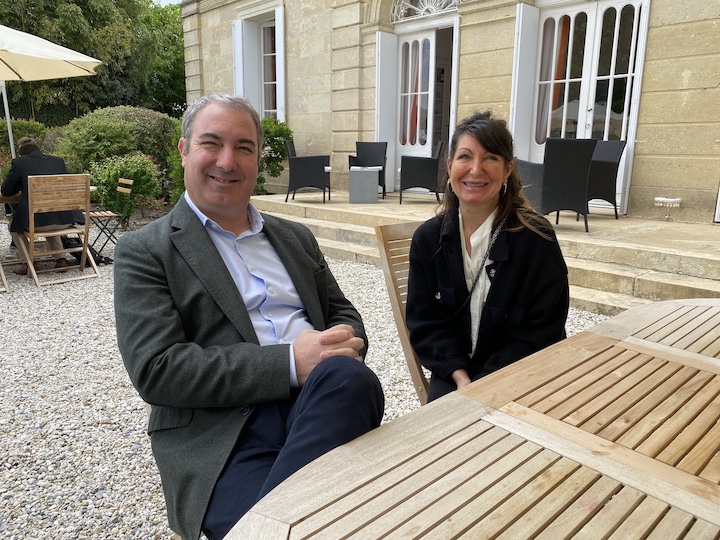
With wine writer Yohan Castaing and Juliette Bécot of Château Beau-Séjour Bécot: lunch at Château Belgrave
Château Latour à Pomerol Pomerol – Another 100% Merlot from vines grown on deep clay. Subtle aromatics, as if you can “sense” the wet clay overlaid by veritable freshness and dark fruits of blackberry and plum. A sophisticated wine as the palate exudes subtle density, undeniably present. One of the more exciting wines of the vintage. Chocolate finesse on a long finish. So well balanced! Ok, you sense some headiness, but the low pH balances overall. 95-97
Château Calon Ségur 3ème Cru Classé Saint Estèphe – I had not been to this estate since they changed back to hosting tastings in a more classical room, after a brief period when the estate overreacted to its once very classical image. It is a long story, but suffice to say that this is the best Calon I have had en primeur since about 10 years (I did not taste the 2019, which I understand is even better than 2020). This wine exudes floral notes, with very fine tannin, precise pencil lead aspects, graphite, and leads to a long finish with lift. If the 2019 is better, it must be amazing, because while I respect Montrose and Cos d’Estournel in 2020 more on intellect, I embrace Calon with my heart, pardon the pun. It blends 78% Cabernet Sauvignon, 12% Merlot, 9% Cabernet Franc and 1% Petit Verdot, clocking in at 13.8% alcohol: what a pleasant difference when compared to the heavier (and less appealing) 2018 vintage. Aging in 100% new oak, which is integrating very well. I came away thinking that I really would like to buy this wine, and you should, too. 95-97
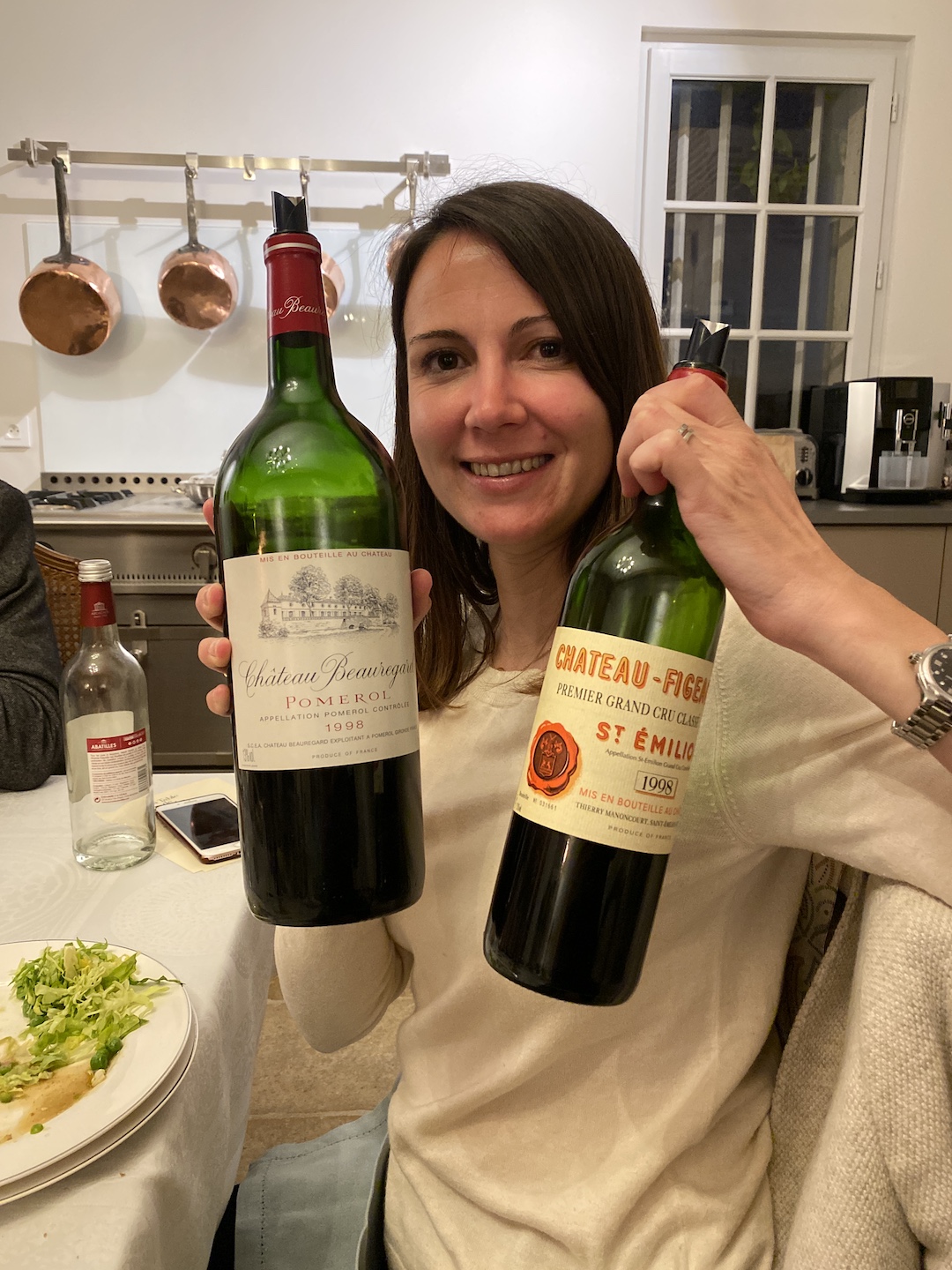
Petit Village is excellent in 2020, and it was fun having dinner with Deputy General Director Diana Garcia Berrouet and friends at Château Beauregard, just across the street, with older vintages.
Château Petit Village Pomerol – Both fresh and dense, with juiciness on the mid palate and an overall supple nature. And yet the tannins are prominent. Tasted after Petrus, Petit Village does not suffer too much by comparison, only the tannins are not quite as fine grained, but the price will be far lower, so… The finish has a fresh, mentholated aspect, perhaps reflecting the 32% Cabernet Franc and 8% Cabernet Sauvignon, with 60% Merlot lending juicy succulence. Picked between 9-23 September, with the trickle of mid August rain providing needed freshening, the resulting wine shows indeed an exciting nose of mint freshness and ripe fruit and spice. Half of the harvest went into this first wine, especially from grapes grown on vines with clay soils, yet again showing the success of the cooler sectors in 2020, which better resisted the arid summer. 95-97
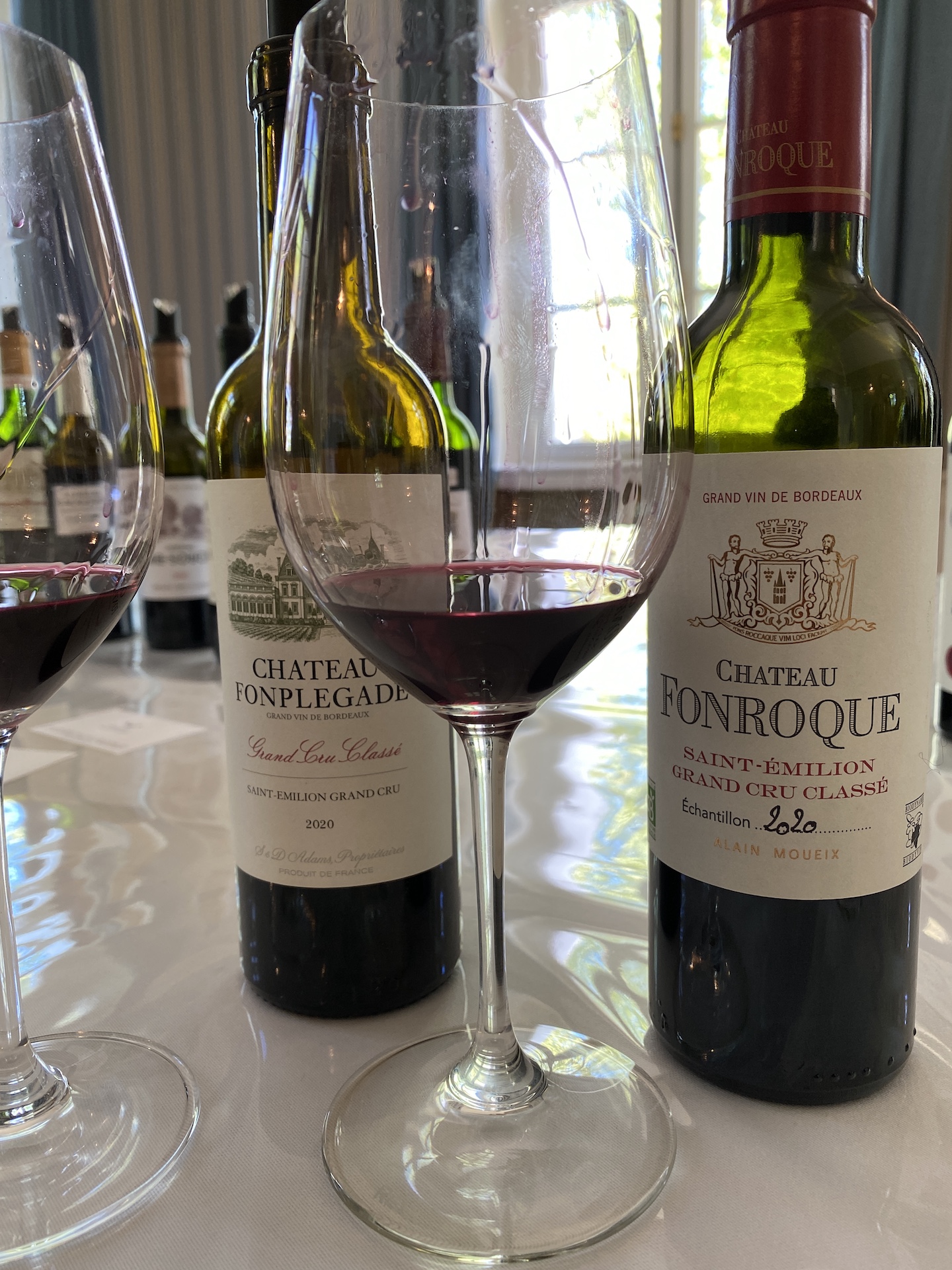
Two top Saint Emilion Grands Crus Classés among many excellent wines in this category in 2020
Château Fonplegade Grand Cru Classé Saint Emilion – Blending 90% Merlot and 10% Cabernet Franc, this estate is both biodynamic and organic for the first time in 2020. It reflects the limestone plateau (40% of the vineyard) and the clay-limestone slopes, with the barrel sample exuding vivid wet stone nose freshness, bright fruit, fine acidity, elegance and refinement… and a gorgeously long finish. I cannot recommend enough purchasing this wine, which resembles more a “Premier Grand Cru” category level in terms of quality. A no-brainer: Buy it! 95-96+
Les Perrières de Lafleur Bordeaux Supérieur – The best Bordeaux Supérieur of the vintage: As Omri Ram of Château Lafleur remarked, this three-hectare estate reflects “mother fucking limestone!”. Indeed, what fabulous freshness on the nose, exuding wet stone and bright fruit, with depth derived from clays as well. This is a connoisseur’s wine that has velvet over a trapeze act tightrope. A very long finish, with gorgeous finesse and tightness. Introduced in 2018, the wine comes from vines located on the southwestern ridge of the Fronsac plateau. And you guessed it : with highly calcareous soils ideal for 2020, where the Guinaudeaus wanted to see how the Bouchets would be expressed from the genetic lines of Château Lafleur. So far, so good, as they make up 71% of the blend and the rest is Merlot, all picked by 19 September for freshness. Superb wine! 95-96+
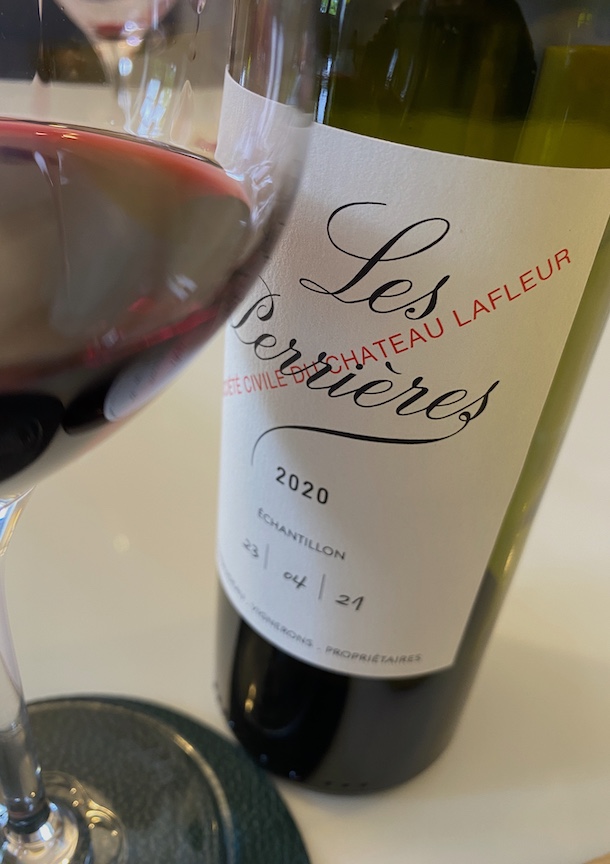
Superb!
Château Bellevue Grand Cru Classé Saint Emilion – For what should be under $60, this fabulous wine is superbly succulent and fresh. Like a “unicorn” with such vivacious energy and juicy density from the 100% Merlots, from vines grown along the upper slopes mainly, but some also on the limestone plateau. Floral and crisp red fruit matches darker ripe fruit aspects. It has 14.6% alcohol, but well integrated and balanced. “An ideal vintage for Merlot,” says Hubert de Boüard. Absolutely. Buy this one, too! 95-96

Château Angélus is the star attraction with Stéphanie de Boüard-Rivoal, Emmanuelle d’Aligny-Fulchi, and Hubert de Boüard but Château Bellevue stole the show for me in 2020. Look at all those other wines, too, including single variety wines. Pretty cool.
Château Grand Puy Lacoste 5ème Cru Classé Pauillac – A great success at this estate, as tasted at the UGCB, and should easily fall into the bargain category, depending on the release price. If the price is like 2019, this would be a no brainer. I love the pencil lead purity, the power and refinement of tannin. Indeed, suave tannin matches density and power in this blend of 76% Cabernet Sauvignon and 24% Merlot, at 13.5% alcohol and aging in 75% new oak. What impressive length! Sure, a touch of extraction felt, but the type of tannin that oak aging will tame. A great vintage in the making! 95-96
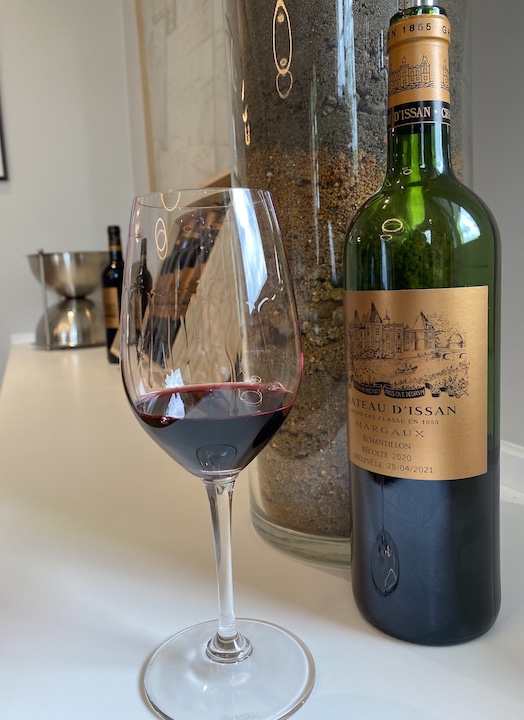
Cross section of clay soils at Issan, for near record Merlots in the blend in 2020
Château d’Issan 3ème Cru Classé Margaux – Tasted twice, at the UGCB and at the estate, and a top wine in 2020. Juicy and refined, with mid-palate sap leading to a long finish, marked by floral freshness. 2020 is the first vintage to incorporate grapes from vines the estate purchased from what was Château Pontac Lynch: vines bordering Château Margaux itself with new varieties for Issan, including Petit Verdot and Malbec. Not surprisingly, 2020 blends almost the highest percentage ever of Merlot here: 55% Cabernet Sauvignon, 39% Merlot, 3% Cabernet Franc, 2% Petit Verdot and 1% Malbec. Emmanuel Cruse remarked that clay subsoil helped “for sure” in making a difference in 2020. Some notions of stricter tannin but the mid-palate sap is delectable. Last year’s blend by contrast was 70% Cabernet Sauvignon and 30% Merlot, and I tip my hat more to 2019, but the 2020 is so appealing that it is hard to say. I am sure that the price will constitute a bargain. 95-96
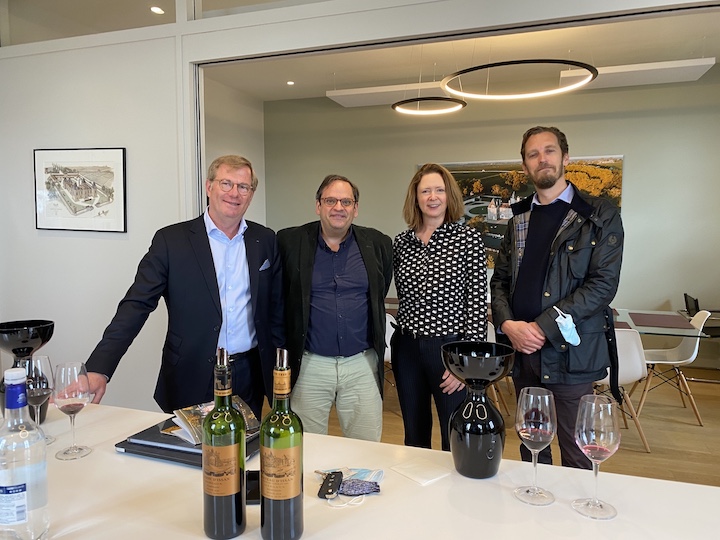
With Emmanuel Cruse and Jane and Francis Anson at Château d’Issan
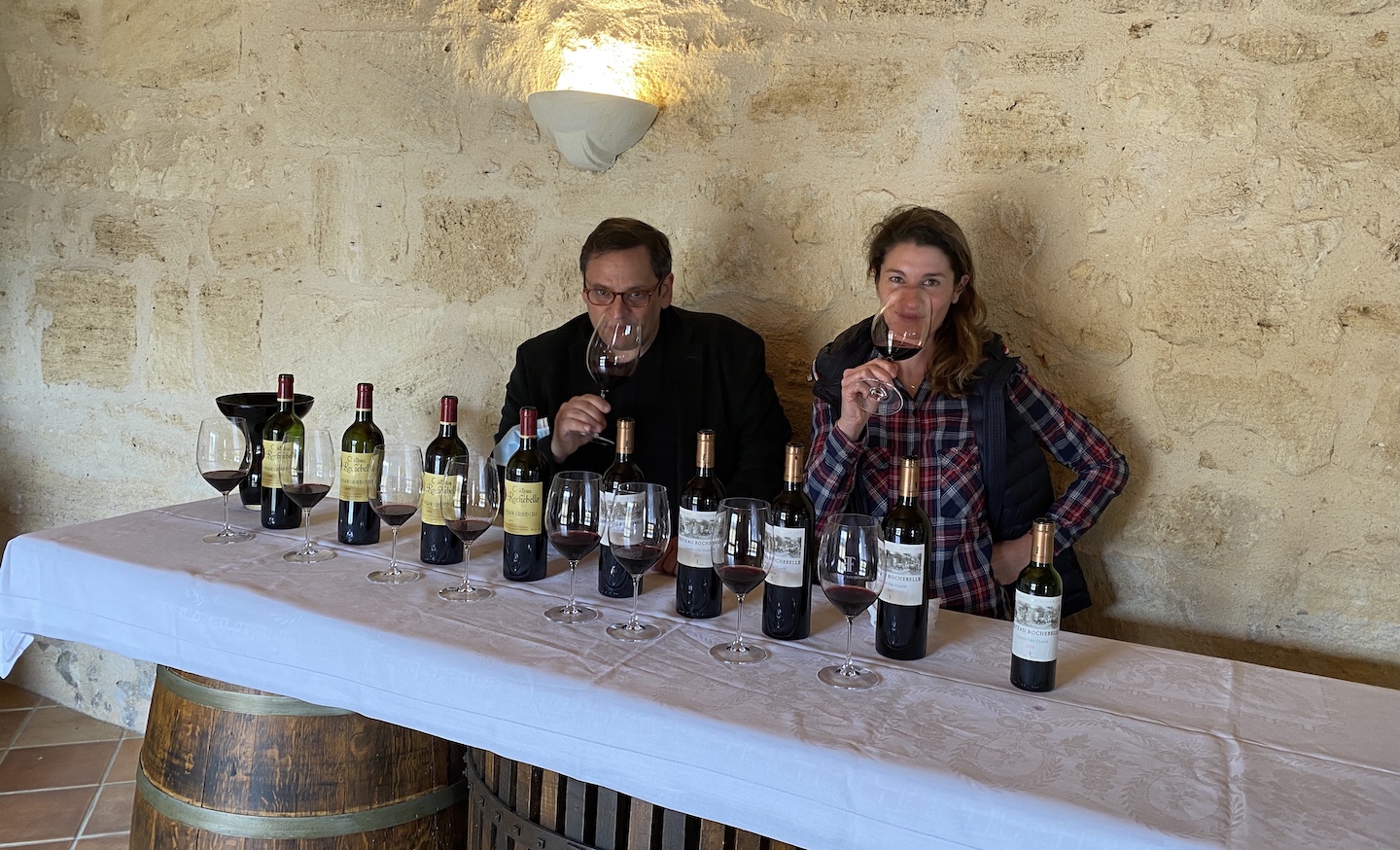
A vertical of Rochebelle shows how lovely these wines can be over time, and still under the radar. Maybe I should just say that they suck, so you do not buy them. 😁
Château Rochebelle Grand Cru Classé Saint Emilion – Tasted at a vertical at the estate (2006-2020), and at Château Dassault, with consistent notes. Harvested by 28 September, reflecting the precocity of the vintage. Raspberry and violet floral aspects, velvety tannins and impressive density with fine balance. All reflecting the estate’s three hectares of vines grown on the Astéries limestone plateau close to Troplong Mondot. This wine deserves your attention, as it reflects a true notion of “wet stone” from the terroir. The blend is 85% Merlot and 15% Cabernet Franc, rather typical. Cropped at 41 hectoliters per hectare, it had a finish of subtle finesse. 94-96
Château Villemaurine Saint Emilion Grand Cru Classé* – Coming from superb terroir including vine plots on the limestone slope near the main town of Saint Emilion, this wine continues to improve in expression in recent years. This vintage blends 80% Merlot and 20% Cabernet Franc, clocking in at 14.3% alcohol. Judicious extraction leads to a delectable, juicy and engaging barrel sample with bright, ripe tannin and fruit: a wine to seek for a fine price/quality ratio, fully reflecting its Grand Cru Classé status. Bravo! (UGCB) 93-95+
Château Branaire-Ducru 4ème Cru Classé Saint Julien – With a release price in the U.S. at under $50, a very good deal for wine that exemplifies “Saint Julien elegance”, with soft if somewhat high-toned fruit aromas. The palate has charm, a bit tight, as I would expect the tannins to be high as in other parts of Bordeaux in 2020, but not especially hard either. A fine vintage here indeed but note again the presence of higher than average Merlots in the blend, which is 58% Cabernet Sauvignon, 33% Merlot, 5% Petit Verdot and 4% Cabernet Franc, clocking in at …14.5% alcohol. 93-95
Château de Pez Saint Estèphe – Playing at the level of a Cru Classé, this blend of 49% each of Merlot and Cabernet Sauvignon with 4% Cabernet Franc and 1% Petit Verdot counts among the most successful Saint Estèphes in 2020, with cool tobacco leaf, refined freshness, and some austerity but “soft”, meaning that it will age nicely with structure for the longer haul. Should cost under $50, and you should buy it. 93-95
Château Phélan Ségur – Another former Cru Bourgeois Exceptionnal playing at Cru Classé level, and the cooler clay soils of Saint Estèphe certainly helped in 2020. Impressive mid palate and larger scaled than the excellent Haut Marbuzet, tasted just before, with mid-palate power and foreboding but not harsh tannin. Indeed, I like the cool finish. This blend of 54% Cabernet Sauvignon, 42% Merlot and 2% each of Cabernet Franc and Petit Verdot should turn out very good indeed. 93-95
Château Malartic Lagravière – I like the cool blueberry and ripe plum aspects from this blend of almost equal parts Merlot (just over 47%) and Cabernet Sauvignon (just over 50%) with the rest Cabernet Franc. Underlying clay and limestone lent freshness to this wine, clocking in at 14.2% alcohol. But there is power in the tannins, structure for the longer haul. With Eric Boissenot consulting, I notice now a subtle change in style for the better: a bit more juiciness and airy elegance overall. 93-95
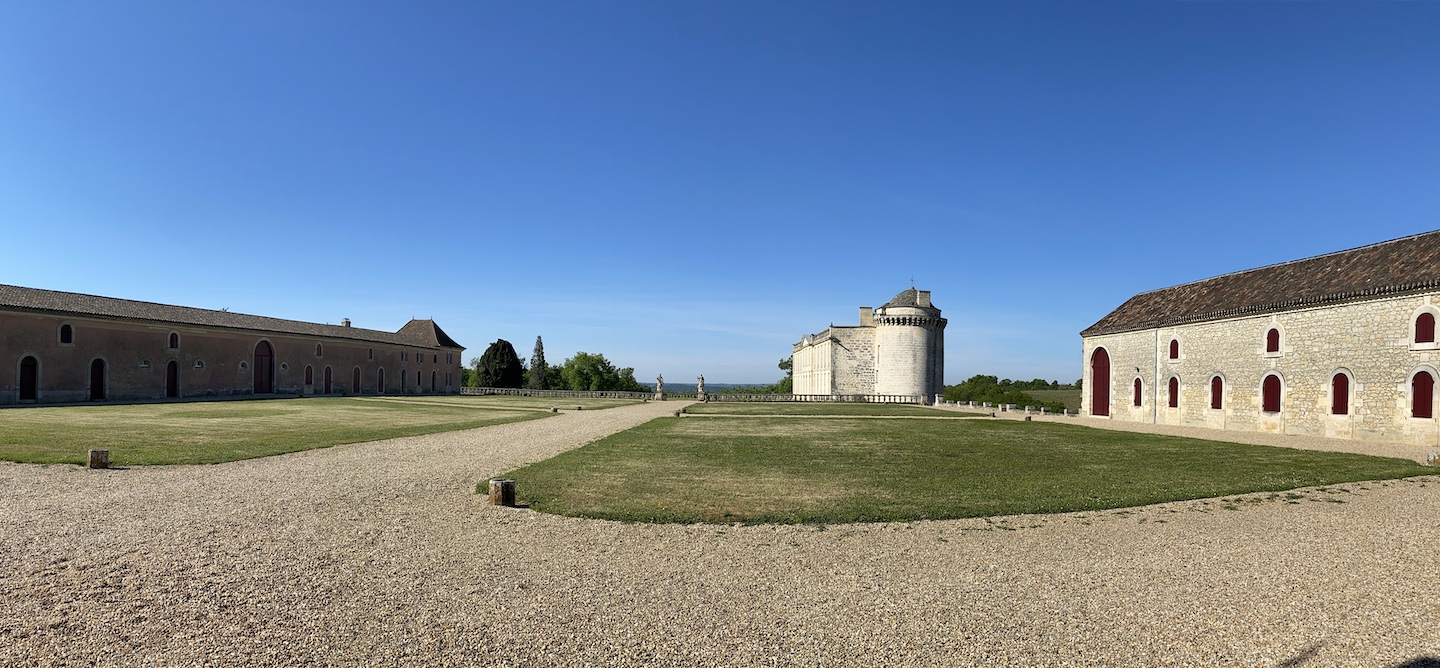
Saint Emilion well present in all Top 50+ categories: especially from vines growing in deep clay and limestone soils.
20 (i)Deals* Part 2 (all have “asterisks” for expected superb price/quality ratios, but Part 2 is even less expensive than Part 1)
Château Le Prieuré Grand Cru Classé Saint Emilion – Blending 83% Merlot and 17% Cabernet Franc, the wine shines in its expression of limestone freshness, yet includes opulence in its 14.3% alcohol. A wine that is juicy, bright and chalky that gets better in glass. The vineyard is superb, split into 19 sections including vine plots close to Trottevieille, Troplong Mondot and Pavie-Macquin (not bad real estate!), with this first wine made from grapes grown on the limestone plateau. 93-94
Château La Serre Grand Cru Classé Saint Emilion – Blending 85% Merlot and 15% Cabernet Franc, yet another gorgeous expression of Merlot and limestone terroir, as most vines here are on the plateau. And what smooth tannin with wet stone delight! While it may not reach the heights of either Fonroque or Fonplegade, this wine illustrates yet again how yummy Saint Emilion can be in 2020. 93-94
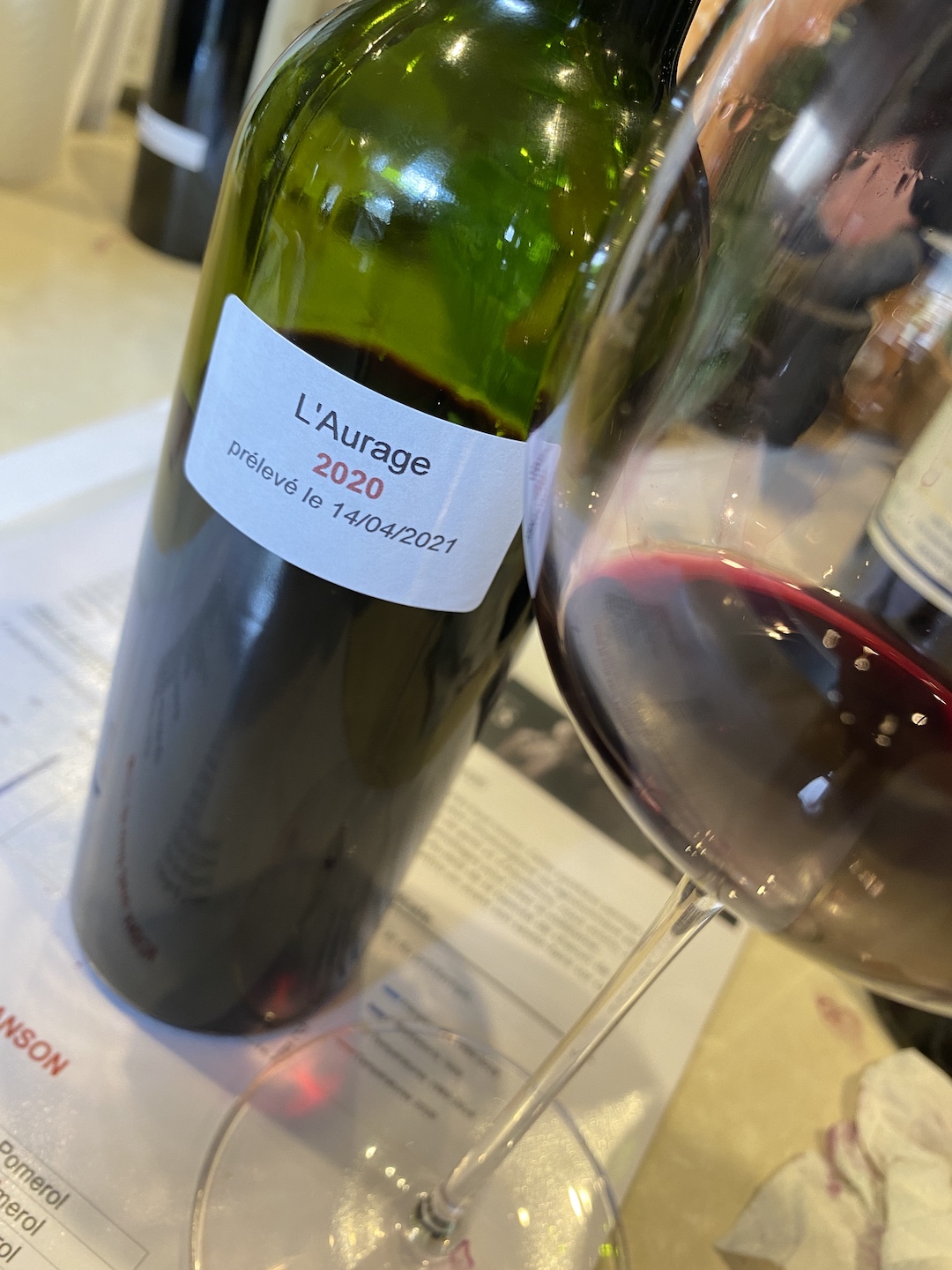
Château L’Aurage Castillon Côtes de Bordeaux – Crafted by the Mitjaville Family of the famous Saint Emilion estate Tertre Roteboeuf, I just love their Castillon wine because of its bright and deep dark ripe fruit combination with such purity and freshness. There is a gorgeous core to the wine, mid palate sap with fine texture that is utterly seductive. 93-94 Bravo!
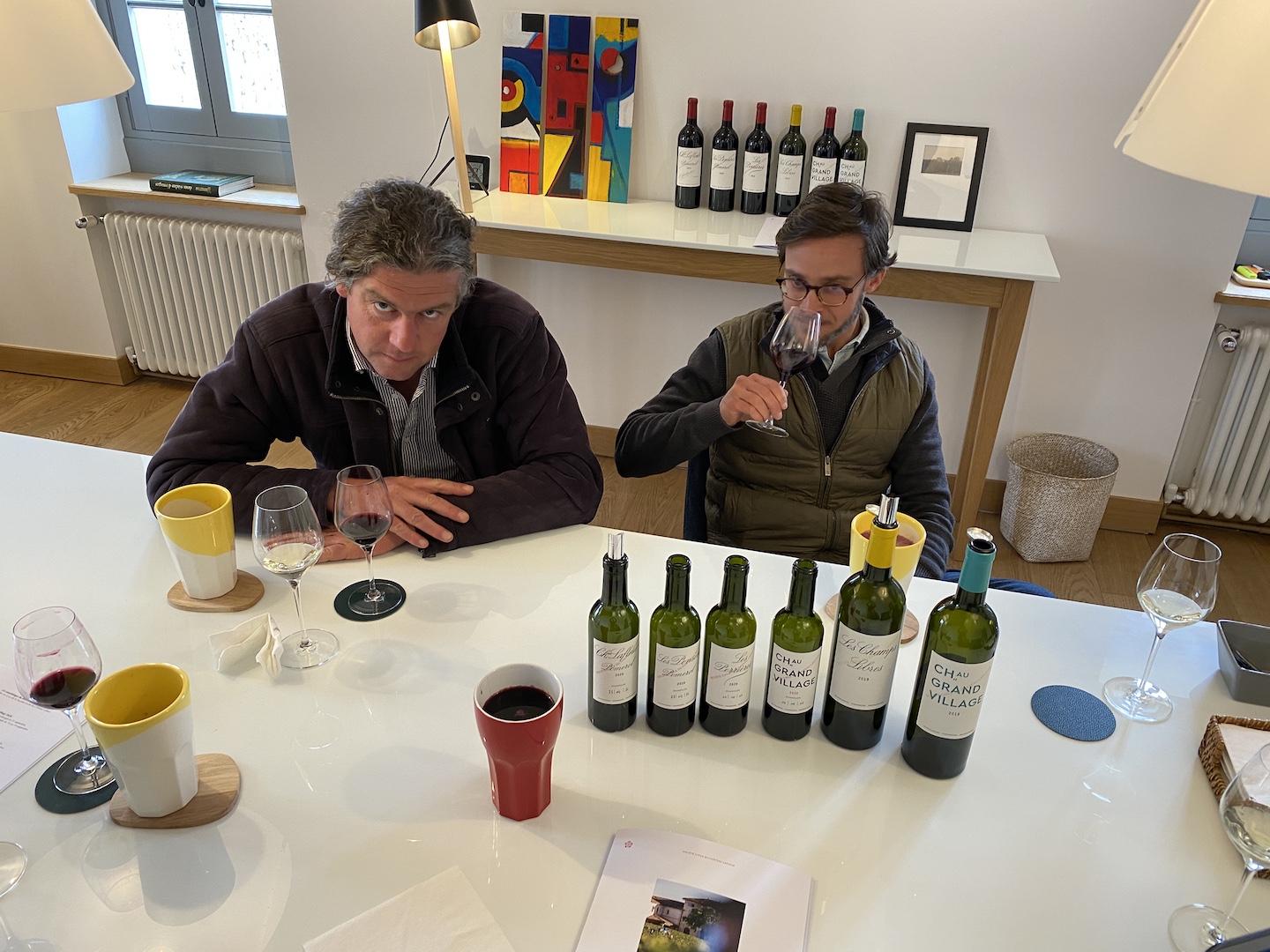
These guys even make some great whites. Magic at Château Lafleur, which I did not spit out.
Château Grand Village Bordeaux Superior – For a Bordeaux Superior, from the same team at Château Lafleur, a top affordable wine of the vintage: Such finesse, such fine quality tannin, such freshness! Very floral and oh-so scrumptuous on the palate. Of all the estates run by this talented team, here one finds the coolest soil – 14 hectares of clay-limestone – located north of the Fronsac appellation: very useful in hot, dry vintages like 2020, and is made with the “same DNA” as the grand vin. One could say, as in Burgundy, that this amounts to a super high quality village wine, while Lafleur is … Musigny. Aging in 30% new oak. About €15 a bottle: One would be a total idiot not to buy this. 92-94
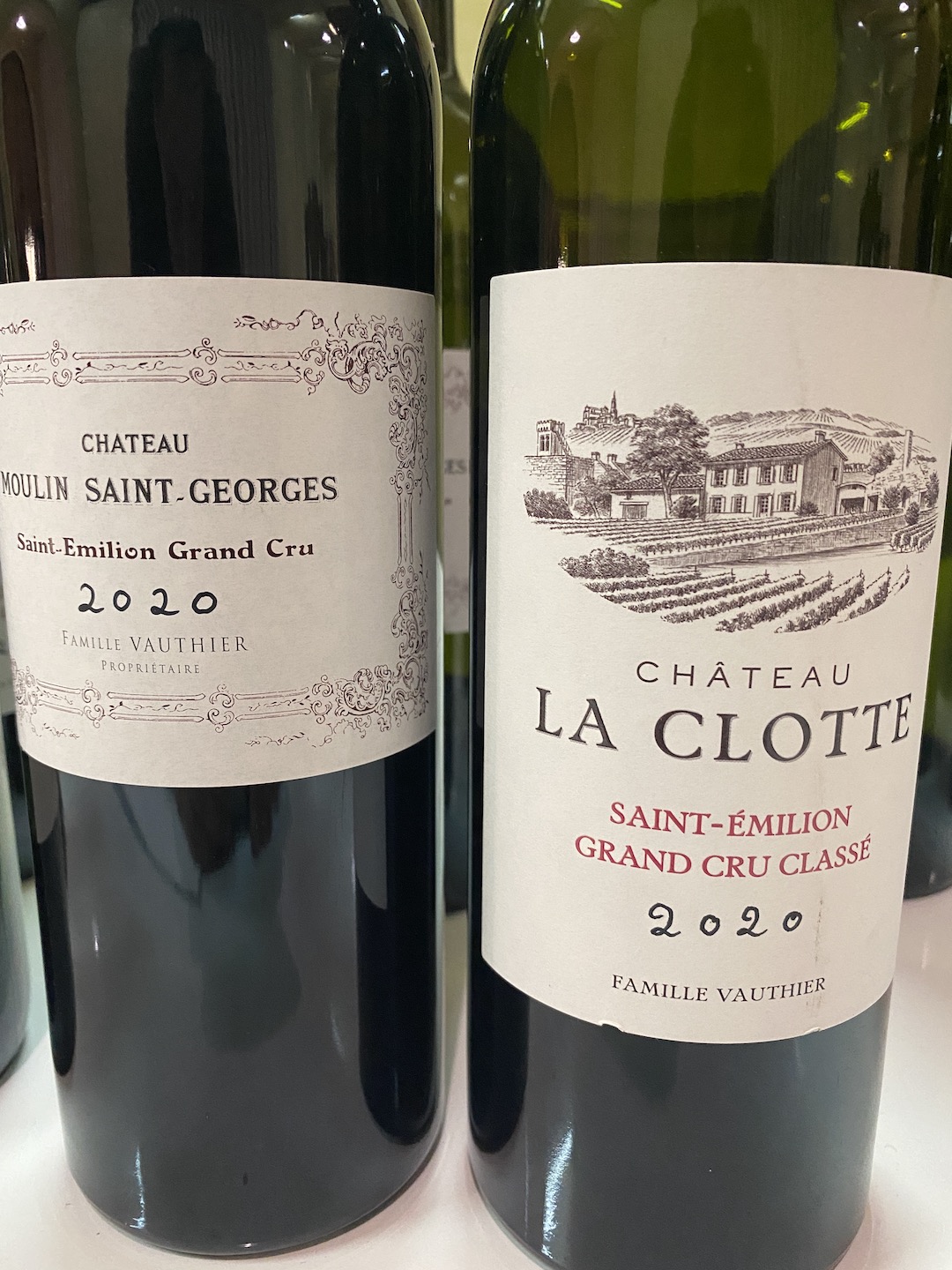
The Moulin Saint Georges, at left, is not a Cru Classé but tastes like one. Great deal!
Château Moulin Saint Georges Saint Emilion Grand Cru – One of the stars in this category of non classified Saint Emilion Grands Crus, exuding richness and sensuality. The 14.5% alcohol is well balanced by the acidity in this blend of 85% Merlot and the rest Cabernet Franc. More clay-limestone soil ideal for the Merlots. 92-93
Château Tour Saint Christophe Saint Emilion Grand Cru – Another favorite among the non-classified Saint Emilion Grand Crus that I tried in late April from barrel. Assessed at the estate, this wine should retail for $30: a must to purchase. The 16 hectares of vines enjoy excellent terroir of limestone and clay at Saint Christophe des Bardes, one of the few in Saint Emilion vineyards with northern Rhone like terraces. The alcohol is 14.7% but in fine balance, with a low pH of 3.6. Wet stone, and ripe fruit of course, with black fruit. Orange clementine freshness on the finish. 92-93
Château Potensac Médoc – Year in, year out, this is truly an (i)Deal wine, punching above its weight. Older vines here between 30 and 100 years of age, including old Cabernet Franc. This blend of 44% Merlot, 33% Cabernet Sauvignon, 22% Cabernet Franc and 1% Petit Verdot is juicy and dense and with powerful tannin for structure (the tannic index is 76 IPT). Aging in 20% new oak, it clocks in at just over 14% alcohol. I am a buyer! P.S.: If you see the second wine, Chapelle de Potensac, at a restaurant, it won’t dissapoint, either. 92-93+
Château Poujeaux Moulis – The nose is expressive with bright red and dark fruit. “Aromatically, this is a rather open as a vintage”, remarked co-owner Matthieu Cuvelier. The palate shows more structure but is also fresh and there is tannic power. Tasted twice with consistent positive impressions (at the UGCB and at Clos Fourtet). As is the case with many other estates on the Left Bank, the percentage of Merlot in 2020 is higher than average although not that much more for Poujeaux, which in this vintage blends 50% Cabernet Sauvignon, 45% Merlot and the rest Petit Verdot. “I think 2019 was better on the Left Bank than on the Right Bank, but 2020 is a bit better on the Right Bank compared to Left”, Cuvelier stresses. In any case, this is an excellent Poujeaux, which should not cost too much. Bravo! 92-93
Château Haut Marbuzet – The oak is present but actually quite lovely and refined, and the nose very fresh. On the palate you sense the oak perhaps just a tad but there is enough substance and juiciness to enable integration of oak tannin. Should turn out fine. 92-93
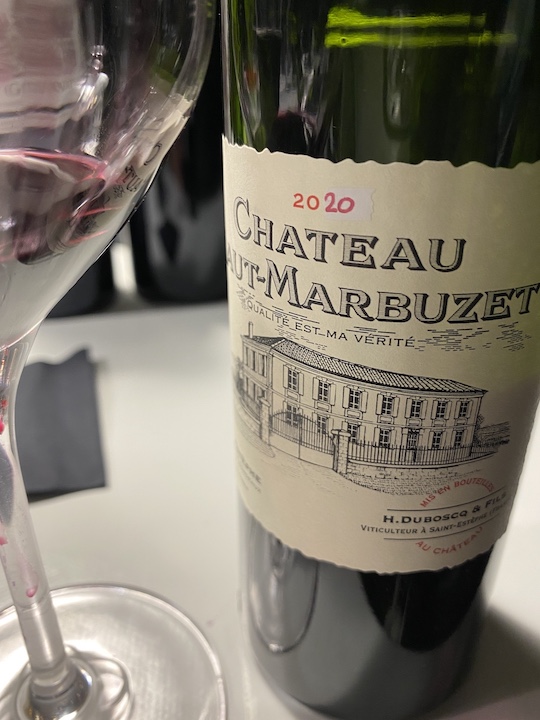
Qualité Est Ma Verité at Haut Marbuzet in 2020 especially.
Château de la Dauphine Fronsac – Great effort in 2020, a wine that is lively, with tannic grip and impressive density. Produced from vines that grow on the hillsides on clay-limestone on Fronsac molasse and asteriated limestone, it comes out to 90% Merlot and 10% Cabernet Franc aged for 12 months in oak barrels 30% new. 92-93+
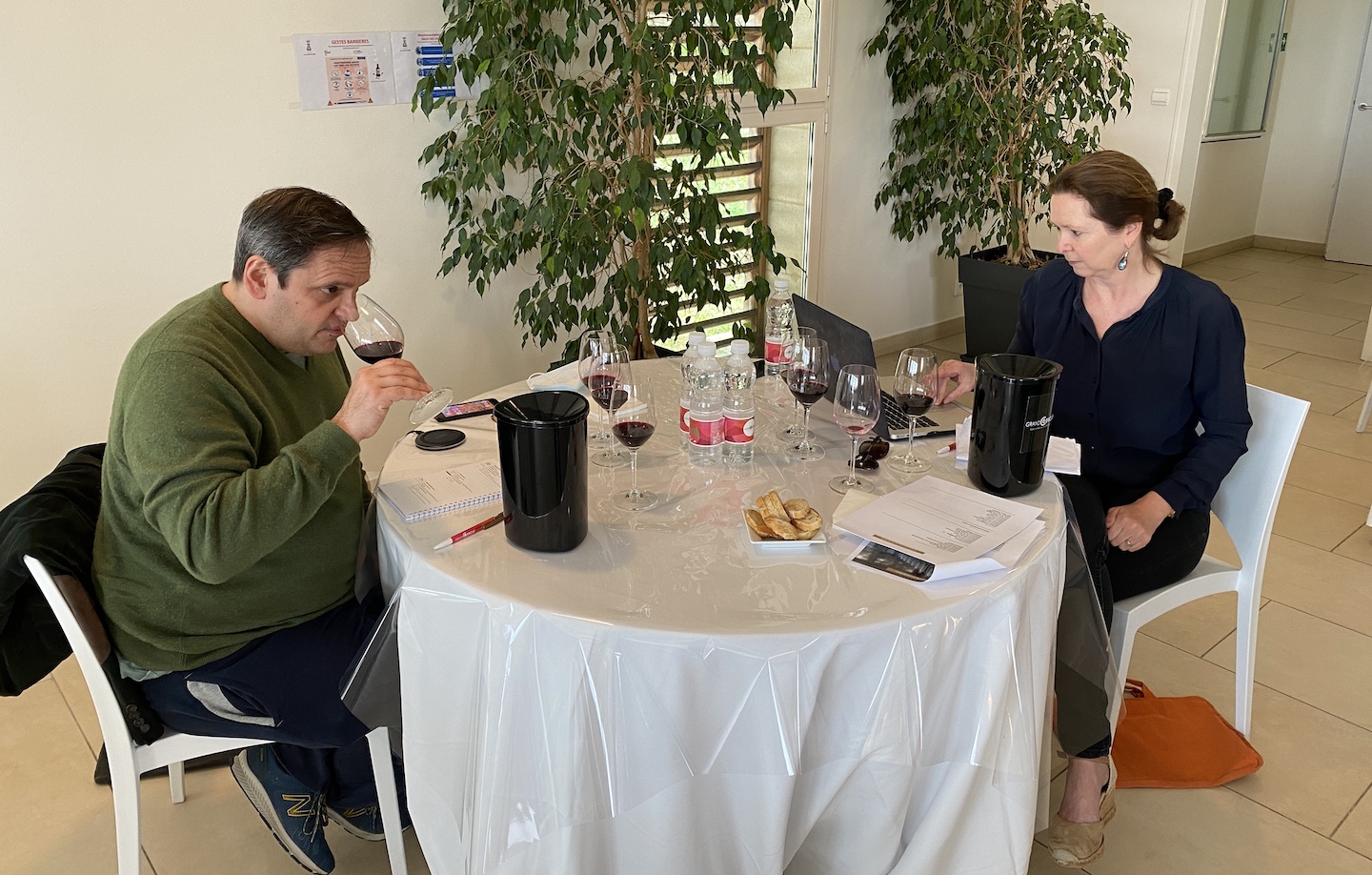
Tasting Fronsacs among many other estate members of the Grand Cercle at Château de la Dauphine with Jane Anson: As even, the Grand Cercle does a great job.
Château Alcée Castillon Côtes de Bordeaux – The cool blue fruit and juicy mid palate seduces to no end for just €10. I like the density and finesse of the tannins. Close to 10 years ago, Nicolas Thienpont bought three hectares in Côtes de Castillon, with vines located at the top of a limestone plateau with red clays underneath. In 2014, he removed one hectare and added 4.5 with plots located not far from Saint Philippe d’Aiguille: new plots also on a limestone plateau with alternating compact clays. 92-93+
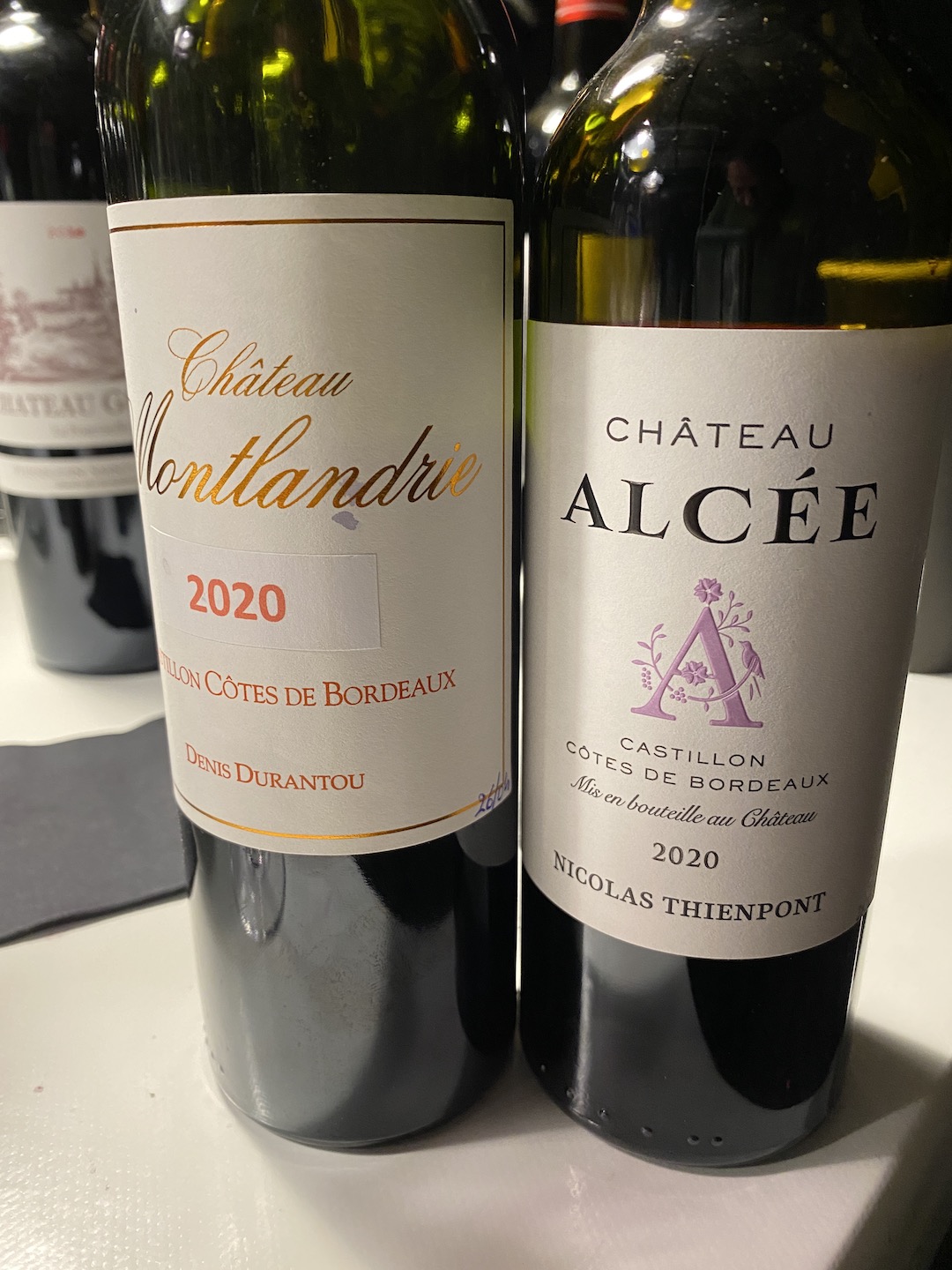
Château Les Trois Croix Fronsac – I like the crushed tobacco coming no doubt from the Cabernet Franc. The wine exudes a lovely, cool nose that precedes a palate of rather refined tannin, ripe fruit and some aniseed. Medium finish. 92-93
Château Moulin Haut Laroque Fronsac – Sweet ripe fruit, touches of powdered chocolate. Tannic austerity on to the finish with a bit of alcohol felt, a touch of warmth. But I just love the palate here: dense and fruit filled! 92-93
Château Lilian Ladouys Saint Estèphe – Refined and fresh. Albeit not as good as the 2019, this wine still comes across fresh and ripe, and will not cost you much. At under $20 release price, do not hesitate. 92-93
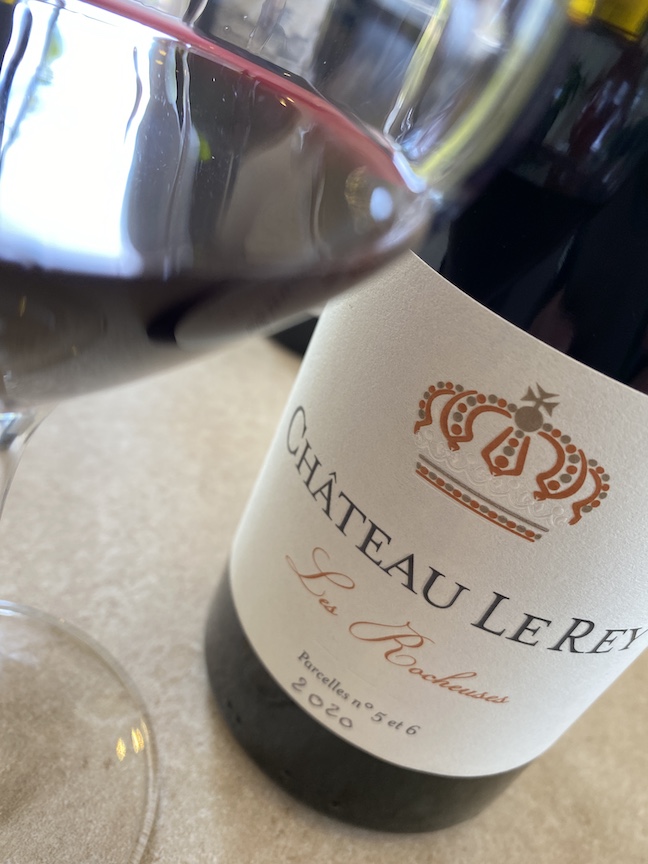
Château Le Rey Les Rocheuses Castillon Côtes de Bordeaux – One of the many fine properties of Vignobles K, the blend of 80% Merlot and 20% Cabernet Franc aging in 40% new oak exudes class, refined tannin and wet stone freshness, coming from the limestone terroir. Also try Les Argileuses crafted from grapes grown on vines in excellent (blue clay), for only $15 retail. But I do prefer Les Rocheuses in 2020 for more subtle aspects and more refinement. This should be about $25 in the U.S. and for a production of only some 5,000 bottles, worth seeking out! 92-93
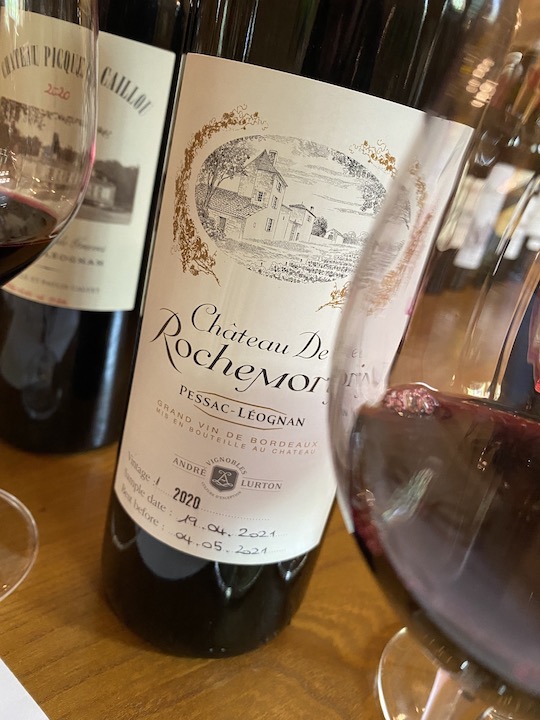
Château de Rochemorin Pessac-Léognan – Tasted among many Graves wines at Château Carbonnieux and this stood out for me in a lower price point for its brownie cake appeal and hint of smoky spice. An important majority of Merlot in the blend this year, and you have a wine both refined and fun to drink at the same time. Do not hesitate! 92-93

Château Les Ormes Sorbet Médoc – Black fruit, plum, cassis, ripe with grip, suave. The vines are located in the cooler northern Medoc, near the Estuary, with some clay underneath and limestone, which makes sense in this vintage for the blend of 65% Cabernet Sauvignon, 30% Merlot and 5% Petit Verdot. Another example of wine with both key subsoils and a cooler microclimate that excelled in 2020. 92-93
Château Siran Margaux – There is such ripe fruit and a velvety smooth aspect to this wine that all I could think of was the word “delicious”. This blend of 47% Merlot, 43% Cabernet Sauvignon and the rest Petit Verdot comes across almost like a Pomerol, and with the gravels do not ask me how. Clocks in at 14% alcohol. Nice job! 92-93
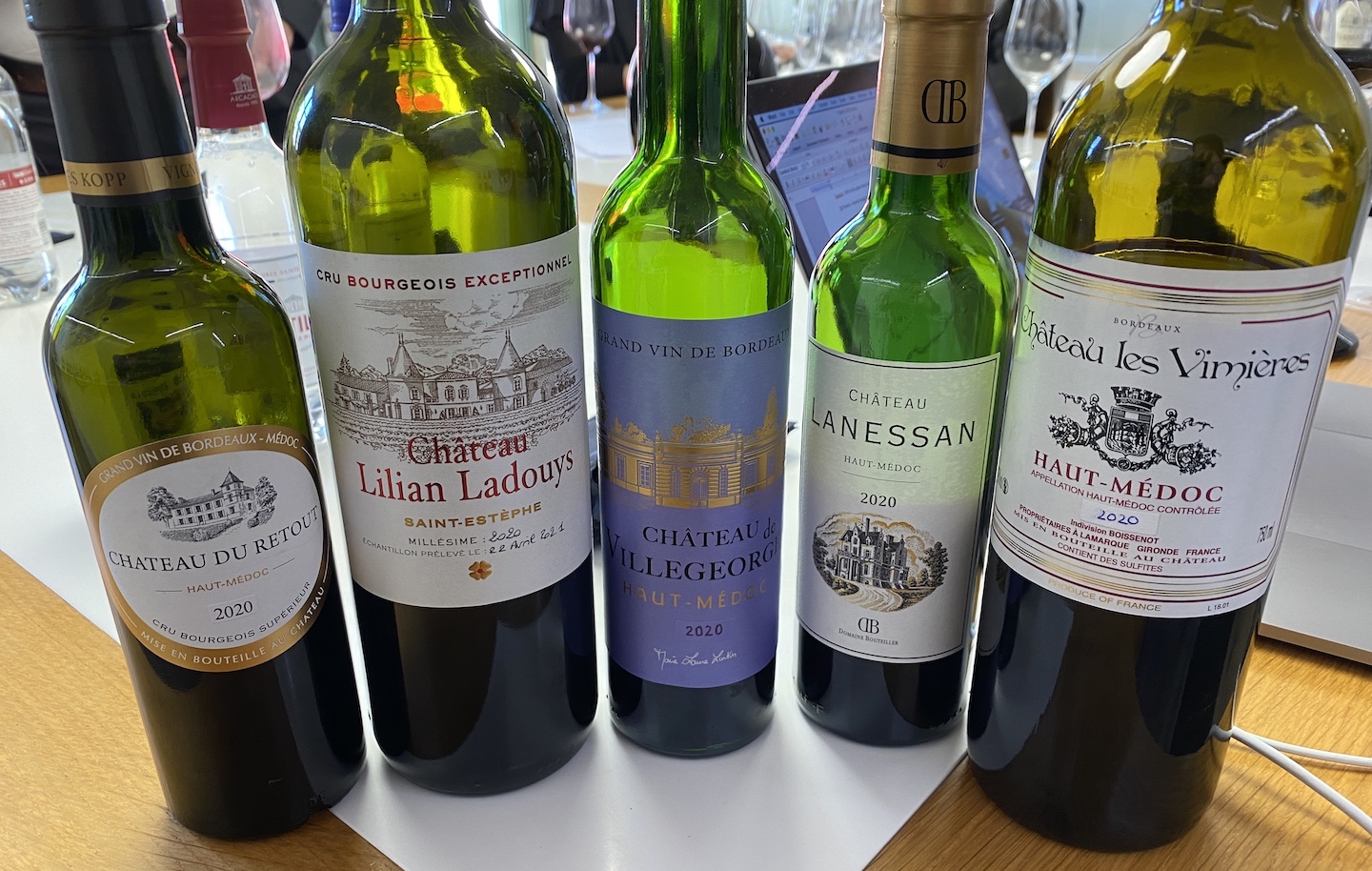
Some excellent values assessed at the lab of wine consultant Eric Boissenot in Pauillac. Could not list them all, but more notes coming.
Château Lanessan Haut Médoc – Excellent precise aromas of pencil lead, ripe plum and cassis, this blend of 52% Cabernet Sauvignon, 43% Merlot and 5% Petit Verdot exudes tasty mid-palate sap, and in a classy manner with fine grained tannin leaving an impression of contained opulence. A suave, rather long finish. 92-93
Château Caronne Sainte Gemme Haut Médoc – Lovely graphite aromatics lead to a palate with a lot of substance, matière, even if the tannins come across somewhat “academic”. But overall, this will nicely profit from barrel aging. Tasted at Joanne, the negociant and it really is a strong Haut Médoc for not much money. 92-93
Note for the estates
If your wine did not “make” this Top 50+ list, no worries! I probably erred in leaving some out or picking some over others. Plenty other great wines to be reviewed in the near future as divided by appellation. For the record, I did not taste Château Beausejour Duffau Lagarrose, Ducru Beaucaillou and the wines of Domaine Clarence Dillon (Haut Brion, La Mission Haut Brion), but I hope to get to them later this year.
 Wine Chronicles
Wine Chronicles
Share This